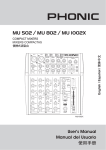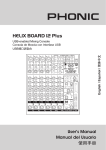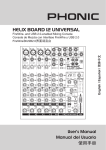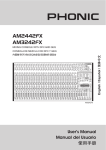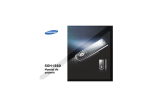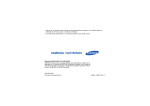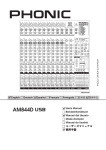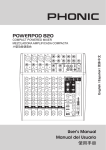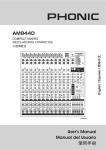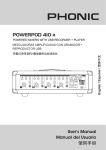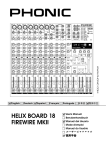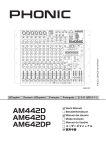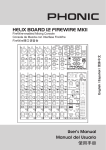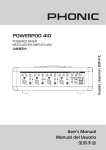Download impact 8.4 / 12.4 / 16.4 / 24.4 impact 8.4x / 12.4x / 16.4x / 24.4x
Transcript
IMPACT 8.4 / 12.4 / 16.4 / 24.4 IMPACT 8.4X / 12.4X / 16.4X / 24.4X English / Español / 简体中文 MIXING CONSOLE CONSOLA DE MEZCLA 调音台 IMPACT 8.4X User’s Manual Manual del Usuario 使用手册 IMPACT 8.4 / 12.4 / 16.4 / 24.4 IMPACT 8.4X / 12.4X / 16.4X / 24.4X MIXING CONSOLE CONSOLA DE MEZCLA 调音台 CONTENTS CONTENIDO 目录 INTRODUCTION 4 INTRODUCCIÓN 14 简介 24 FEATURES 4 CARACTERISTÍCAS 14 特色 24 BASIC SETUP 4 CONFIGURACIÓN BÁSICA 14 基本设定 24 GETTING STARTED 4 INICIANDO 14 准备工作 24 CHANNEL SETUP 4 CONFIGURACIÓN DE CANAL 14 声道设置 24 MAKING CONNECTIONS 5 HACIENDO CONEXIONES 15 CONNECTING PANEL 5 PANEL DE CONEXIÓN 15 连接面板 25 REAR PANEL 6 PANEL DE DORSO 16 后面板 25 MAIN MIXING PANEL 6 PANEL PRINCIPAL DE MEZCLA 16 主混音面板 26 CONTROLS AND SETTINGS 6 CONTROLES Y AJUSTES 16 REAR PANEL 6 PANEL DE DORSO 16 后面板 26 CHANNEL CONTROLS 7 CONTROLES DE CANAL 16 声道控制 26 DIGITAL EFFECT ENGINE 8 MOTOR DE EFECTO DIGITAL 18 数字效果处理器 27 TAPE IN SECTION 9 SECCIÓN DE ENTRADA DE TAPE 19 录音输入控制区 27 MASTER CONTROL SECTION 9 SECCIÓN DE CONTROL MASTER 19 主控制区 27 连接设置 控制和设定 25 26 SPECIFICATIONS 11 ESPECIFICACIONES 21 规格 29 DIGITAL EFFECT TABLE 31 TABLA DE EFETOS DIGITALES 31 数字效果器表 31 APPLICATIONS 32 APLICACIONES 32 应用 32 DIMENSIONS 34 DIMENSIONES 34 尺寸 34 BLOCK DIAGRAM 35 DIAGRAMA DE BLOQUE 35 线路图 35 Phonic preserves the right to improve or alter any information within this document without prior notice Phonic se reserva el derecho de mejorar o alterar cualquier información provista dentro de este documento sin previo aviso PHONIC保留不预先通知即可更新本手册的权利 V1.0 11/21/2008 IMPORTANT SAFETY INSTRUCTIONS The apparatus shall not be exposed to dripping or splashing and that no objects with liquids, such as vases, shall be placed on the apparatus. The MAINS plug is used as the disconnect device, the disconnect device shall remain readily operable. Warning: the user shall not place this apparatus in the can be easily accessible. area during the operation so that the mains switch 1. Read these instructions before operating this apparatus. CAUTION 2. Keep these instructions for future reference. RISK OF ELECTRIC SHOCK DO NOT OPEN 3. Heed all warnings to ensure safe operation. 4. Follow all instructions provided in this document. 5. Do not use this apparatus near water or in locations where condensation may occur. 6. Clean only with dry cloth. Do not use aerosol or liquid cleaners. Unplug this apparatus before cleaning. 7. Do not block any of the ventilation openings. Install in accordance with the manufacturer’s instructions. 8. Do not install near any heat sources such as radiators, heat registers, stoves, or other apparatus (including . 9. Do not defeat the safety purpose of the polarized or grounding-type plug. A polarized plug has two blades with one wider than the other. A grounding type plug has two blades and a third grounding prong. The wide blade or the third prong is provided for your safety. If the provided plug does not into your outlet, consult an electrician for replacement of the obsolete outlet. 10. Protect the power cord from being walked on or pinched particularly at plug, convenience receptacles, and the point where they exit from the apparatus. 11. Only use attachments/accessories manufacturer. by the 12. Use only with a cart, stand, tripod, bracket, or table by the manufacturer, or sold with the apparatus. When a cart is used, use caution when moving the cart/apparatus combination to avoid injury from tipover. 13. Unplug this apparatus during lighting storms or when unused for long periods of time. 14. Refer all servicing to service personnel. Servicing is required when the apparatus has been damaged in any way, such as power-supply cord or plug is damaged, liquid has been spilled or objects have fallen into the apparatus, the apparatus has been exposed to rain or moisture, does not operate normally, or has been dropped. CAUTION: TO REDUCE THE RISK OF ELECTRIC SHOCK, DO NOT REMOVE COVER (OR BACK) NO USER SERVICEABLE PARTS INSIDE REFER SERVICING TO QUALIFIED PERSONNEL The lightning flash with arrowhead symbol, within an equilateral triangle, is intended to alert the user to the presence of uninsulated “dangerous voltage” within the product’ magnitude to constitute a risk of electric shock to persons. The exclamation point within an equilateral triangle is intended to alert the user to the presence of important operating and maintenance (servicing) instructions in the literature accompanying the appliance. WARNING: To reduce the risk of or electric shock, do not expose this apparatus to rain or moisture. CAUTION: Use of controls or adjustments or performance of procedures other than those may result in hazardous radiation exposure. INTRODUCTION BASIC SETUP Thank you for choosing one of Phonic’s many quality compact mixers. The Impact mixing consoles - designed by the same talented engineers that have created a variety of mixers fantastic in style and performance in the past - display similar proficiency that previous Phonic products have shown; with more than a few refinements, of course. GETTING STARTED With a total of 8 models in the Impact series, the Impact 8.4, Impact 12.4, Impact 16.4, Impact 24.4, Impact 8.4 X, Impact 12.4 X, Impact 16.4 X, and Impact 24.4 X, all with varying inputs yet displaying the same efficacy, you have no doubt purchased a mixer that will not only proove ideal for your application, but will outlast many others. We know how eager you are to get started - wanting to get the mixer out and hook it all up is probably your number one priority right now - but before you do, we strongly urge you to take a look through this manual. Inside, you will find important facts and figures on the set up, use and applications of your brand new mixer. If you do happen to be one of the many people who flatly refuse to read user manuals, then we just urge you to at least glance at the Instant Setup section. After reading through the manual, please store it in a place that is easy for you to find, because chances are there is something you missed the first time around. FEATURES ● Audiophile-Quality & ultra low noise ● Mono channels with inserts and phantom power ● 2 stereo channels with 4-band EQ ● 10, 14, 18, 26 mic preamps on Impact 8.4/8.4X, 12.4/12.4X, 16.4/16.4X, 24.4/24.4X ● 3-band EQ with swept mid-range plus low cut on each mono channel ● 18dB/oct, 75Hz low cut filter on each mono channels ● 4 aux sends, aux 1 & 2 with XLR and 1/4” output jacks ● 2 stereo aux returns, each with effect to monitor ● Pad on mono channels to handle difficult signals ● Main Stereo and Mono output with XLR and 1/4” jacks ● Mono output with variable low pass filter for subwoofer speaker ● Tape input can be routed to aux 1 and aux 2 1. Ensure all power is turned off on the Impact Mixer. To totally ensure this, the AC cable should not be connected to the unit. 2. All faders and level controls should be set at the lowest level and all channels switched off to ensure no sound is inadvertently sent through the outputs when the device is switched on. All levels should be altered to acceptable degrees after the device is turned on. 3. Plug all necessary instruments and equipment into the device’s various inputs as required. This may include line signal devices, as well as microphones and/or guitars, keyboards, etc. 4. Turn the gain of the selected channel to a degree that allows the audio level shown in the level meter to sit around 0 dB, ensuring it never reaches 7 dB.. 5. Plug the supplied AC cable into the AC inlet on the back of the device ensuring the local voltage level is identical to that required on your device. 6. Plug the supplied AC cable into a power outlet of a suitable voltage. 7. Turn the power switch on. CHANNEL SETUP 1. To ensure the correct audio levels of each input channel is selected, every channel should first be switched off and all faders set to 0. 2. Choose the channel that you wish to set the level of and ensure that channel has a signal sent to it similar to the signal that will be sent when in common use. For example, if the channel is using a microphone, then you should speak or sing at the same level the performer normally would during a performance. If a guitar is plugged into that channel, then the guitar should also be used as it normally would be. 3. Press the PFL button of the channel, allowing you to see the audio properties in the level meter. 4. Turn the gain of the selected channel to a degree that allows the audio level shown in the level meter to sit around 0 dB, ensuring it never reaches 7 dB. 5. This channel is now ready to be used; you can stop making the audio signal and disengage the PFL button. 6. You should now select the next channel to set and go back to follow steps 1 through 6. ● Handy mini-stereo I/O for MD, MP3 player/recorder ● Built-in switching power supply with universal connec- tor, 100-240VAC, 50/60Hz ● Optional Rack-mounting kit for Impact 8.4 and Impact 8.4 X only, model name ER8IM ● Impact X models further feature 32-bit DSP digital multi- effect processor with 99 programs IMPACT 8.4/12.4/16.4/24.4/8.4X/12.4X/16.4X/24.4X MAKING CONNECTIONS CONNECTING PANEL 1. XLR Jacks These jacks accept XLR inputs for balanced signals. They can be used in conjunction with microphones such as professional condenser, dynamic or ribbon microphones - with standard XLR male connectors. With low noise preamplifiers, these inputs serve for crystal clear sound replication. NB.When using an unbalanced microphone, please ensure phantom power is switched off. However, when using condenser microphones the phantom power should be activated. 2. Line In Jacks These balanced inputs accept 1/4” TRS and 1/4” TS line inputs for the addition of various music instruments – such as keyboards, drum machines, electric guitars, as well as a variety of other electric instruments. 3. Insert Jacks The primary use for these TRS phone jacks is for the addition of external devices, such as dynamic processors or equalizers, to the corresponding mono input channel. This will require a Y cord that can send and receive signals of the mixer to and from an external processor. The tip of the TRS jack will send the signal from the input channel, and the ring will return the signal back to the mixer (the sleeve is the grounding). 5. Stereo Returns The 1/4” TS Stereo Return inputs are for the return of audio to the Impact mixer, processed by an external signal processor. If really needed, they can also be used as additional stereo inputs. The feed from these inputs can be adjusted using the Stereo Return controls on the face of the mixer. When connecting a monaural device to the AUX Return inputs, simply plug a 1/4” phone jack into the left (mono) input, and the signal will appear in the right as well. 6. Auxiliary (AUX) 1 and 2 Outputs These balanced XLR jacks and unbalanced 1/4” TS phone jacks are the final output of line-level signal fed from the corresponding auxiliary send mixing buses, and are best suited for use with external effect processors or stage monitors. Feeding the output from the Auxiliary outs to an amplifier - and possibly an equalizer - and then to a floor monitor speaker allows artists to monitor their own instruments or vocals whilst performing. 7. EFX (Effect) Sends These 1/4” TS outputs are the final output from the EFX send mixing bus. This feed may be used to connect to an external digital effect processor or even to an amplifier and speakers, depending on your desired settings. 4. Stereo Channels The two stereo channels on the Impact mixers include XLR Mic inputs and 1/4” TS phone jacks. They can be used in conjunction with various stereo devices, such as synthesizers and keyboards. Also, by connecting a mono signal to the left phone jack, the Impact automatically doubles the signal over to the right channel. This is known as jack normalizing. IMPACT 8.4/12.4/16.4/24.4/8.4X/12.4X/16.4X/24.4X REAR PANEL 8 8. Foot Switch Jacks (Impact X only) This port is for the inclusion of a foot switch (non-latchable), used to remotely adjust properties of the Impact X’s built-in Digital Effects Engine. Using a footswitch with this jack will allow users to mute and un-mute the Digital Effects. 9. Control Room / Phones These two 1/4” Phone Jack outputs feed the signal altered by the Control Room level control on the face of the mixer. This output has extensive use, as it can be used to feed the signal from the mixer to an active monitor, for the monitoring of the audio signal from within a booth, among many other possible uses. 10. Mono / Subwoofer Output This male XLR and 1/4” TS output feeds a monaural signal of the Main L-R signals combined, as adjusted by the accompanying level control. This is ideal for use with a mono sound system, or for the addition of a subwoofer to your set of speakers, adding more punch to low frequency sounds. 11. Main Outputs These outputs will output the final stereo line level signal sent from the main mixing bus. The primary purpose of the two male XLR jacks and 1/4” phone jacks is to send the main left and right output signal to external devices, which may include power amplifiers (and in-turn, a pair of speakers), other mixers, as well as a wide range of other possible signal processors (equalizers, crossovers, etcetera). 12. 12V Lamp This XLR socket allows you to attach a 12 Volt (7 Watt) gooseneck lamp, allowing better visability in areas with poor light. 13. Power Connector MAIN MIXING PANEL 14. Tape Inputs The first of these inputs accommodates RCA cables from such devices as tape and CD players. In addition to these inputs, however, Phonic has incorporated a mini stereo port for the inclusion of mini disc (MD), portable CD, and MP3 players (such as the Apple iPod), as well as laptop computers. The line from this feed is directed to the Tape In mixing bus, which users are able to feed to the Control Room, AUX 1 and 2 or Main L/R mixing buses. 15. Record Outputs As with the Tape In ports, these outputs will accommodate RCA cables, able to be fed to a variety of recording devices. Also included are mini stereo ports for the addition of recording devices such as MD players and laptop computers. 16. Headphones Output This output port is best suited for use with headphones, allowing monitoring of the mix. The audio level of this output is controlled using the Control Room / Phones control on the front panel’s master section. CONTROLS AND SETTINGS REAR PANEL 17. Power Switch This switch is used to turn the mixer on and off. Ensure you turn all level controls down before activating. This is for the addition of an AC power cable, allowing power to be supplied to the mixer. Please use the power cable that is included with this mixer only. The Fuse holder, located below the AC Power connector, is, of course, for the Impact’s fuse. If the fuse happens to blow, open the holder cover, and replace the fuse with a suitable replacement (as indicated underneath the power connector). IMPACT 8.4/12.4/16.4/24.4/8.4X/12.4X/16.4X/24.4X CHANNEL CONTROLS 25. EFX 1 and 2 These two controls adjust the level of audio sent from the channel to the EFX 1 and 2 mixing buses. The EFX 2 signal is also sent to the built-in digital effects processor, allowing users to apply effects to the signal. 18. Low Cut Filter (75 Hz) This button, located on all mono channels, will active a high-pass filter that reduces all frequencies below 75 Hz at 18 dB per octave, helping to remove any unwanted ground noise or stage rumble. 26. Pan/Balance Controls This alternates the degree or level of audio that the left and right side of the main mix should receive. On mono channels, the PAN control will adjust the level that the left and right should receive (pan), where as on a stereo channel, adjusting the BAL control will attenuate the left or right audio signals accordingly (balance). 19. PAD Button (Stereo Channels Only) This button, located on channels the final 4 mono channsl of all Impact mixers, attenuates the input signal of the Mic or Line inputs by 20 dB. This gives a greater dynamic range to the input, allowing inputs with higher-level signals to be used without the possibility of clipping. 20. Gain Control This controls the sensitivity of the input signal of the Line/ Microphone input of mono channels. The gain should be adjusted to a level that allows the maximum use of the audio, while still maintaining the quality of the feed. This can be accomplished by adjusting it to a level that will allow the peak indicator occasionally illuminate or slightly lower than this. 27. Mute Button This button mutes the channel, effectively stopping all audio fed into the inputs from being send to the Main L/R mixing bus, as well as the AUX 1, AUX 2, EFX 1 and EFX 2 mixing buses. This indicated just below the button (labeled Peak) will be illuminated when the channel is muted. 21. High Frequency Control This control is used to give a shelving boost or cut of ±15 dB to high frequency (12 kHz) sounds. This will adjust the amount of treble included in the audio of the channel, adding strength and crispness to sounds such as guitars, cymbals, and synthesizers. 22. Middle Frequency Control This control is used to provide a peaking style of boost and cut to the level of middle frequency sounds at a range of ±15 dB. The Impact mixer also provides a sweep control, allowing you to select a center frequency between 100 Hz and 8 kHz. Changing middle frequencies of an audio feed can be rather difficult when used in a professional audio mix, as it is usually more desirable to cut middle frequency sounds rather than boost them, soothing overly harsh vocal and instrument sounds in the audio. Stereo channels differ slightly, in that they feature a High Mid and Low Mid control for adjusting Middle Frequency sounds with set frequencies of 3 kHz and 800 Hz. 23. Low Frequency Control This control is used to give a shelving boost or cut of ±15 dB to low frequency (80 Hz) sounds. This will adjust the amount of bass included in the audio of the channel, and bring more warmth and punch to drums and bass guitars. 24. AUX Controls These two AUX controls alters the signal level that is being sent to the auxiliary 1 and 2 mixing buses, the signal of which is suitable for connecting stage monitors, allowing artists to listen to the music that is being played, or to fed to an external effect processors. IMPACT 8.4/12.4/16.4/24.4/8.4X/12.4X/16.4X/24.4X button is engaged. 28. Peak Indicator This LED indicator (which doubles as a mute indicator) will illuminate when the channel hits high peaks, 6 dB before overload occurs. It is best to adjust the channel level control so as to allow the PEAK indicator to light up on regular intervals only. This will ensure a greater dynamic range of audio. This indicator also doubles as a Mute indicator, when the channel’s mute 29. Sig Indicator This LED indicator shows when the input level reaches -20 dBu, basically showing when a signal is received by the corresponding channel. 30. PFL Button The PFL - or Pre-Fader Listen - button is pushed to allow the signal of a channel to be sent to the CTRL RM/ PHONES mix (pre-fader, post-EQ), for use with either headphones or studio monitors. This allows easier setting of the input gain and tracking of audio by sound engineers. The Sig LED above the button will illuminate when PFL is activated. 31. Channel Level Control This 60 mm fader will alter the signal level that is sent from the corresponding channel to the Main L/R mixing bus. DIGITAL EFFECT ENGINE The following refers to Impact X models only. 32. Digital Effect Display This 2-digital numeric display shows the program number that is currently applied to your EFX audio signal. When you rotate the Program control, you can scroll through different program numbers; however the display will revert back to the original program if a new program is not selected within a few seconds. For a list of available effects, please observe the Digital Effect Table. 33. Sig and Clip Indicators Located within the Digital Effect Display are Clip and Sig LEDs. The Sig LED will light up when any signal is received by the effect processor, and the Clip LED will light up shortly before excessive signals are dynamically clipped. If the Clip LED lights up too often, it may be advisable to turn down one or all EFX controls on input channels to ensure the signal level is not too high. 35. To Aux 1 and 2 Controls These controls allow users to adjust the signal level that is being sent from the Effects Engine to the auxiliary 1 and 2 mixing buses, the signal of which is suitable for connecting stage monitors, allowing artists or engineers to listen to the music that is being played. 36. Mute Button This button mutes the EFX channel, effectively stopping the signal processed by the built-in Effects Engine from being sent to the Main L/R mixing bus. 37. PFL Button The PFL – or Pre-Fader Listen – button is pushed to allow the signal of the Effects Engine to be sent to the CTRL RM / PHONES mix. This allows easier tracking of audio by sound engineers. 38. DSP Effects Fader This 60mm fader will alter the signal level that is sent from the Effects Engine to the Main L/R mix. 34. Program Control This control is used to scroll through the various effects. Turning the control clockwise will allow users to ascend into higher program numbers, and turning it counter-clockwise will allow users to descend into lower program numbers. Pushing this control will apply the new effect. When a tap-delay effect is selected, pressing this control will allow users to select the tapdelay time. By pushing the button several times, the effect processor interprets the time between last two pushes and remembers this as the delay time, until the button is pushed again (this is kept, even after the power is turned off). When the tap delay effect is selected, a small LED will flash within the digital effect display window at the selected intervals. IMPACT 8.4/12.4/16.4/24.4/8.4X/12.4X/16.4X/24.4X TAPE IN SECTION 39. Level Control This controls the level of the signal received through the Tape In mixing bus, to be sent to the Control Room / Phones and/or Main L/R mixing buses, as selected by the user. 40. CTRL RM and MAIN Buttons These buttons allow users to send the Tape In signal to these particular mixes. Sending the Tape In signal to the Control Room mixing bus is useful in monitoring of the signal, whereas sending it to the Main L/R allows users to combine the Tape In signal with the main mix.To avoid any unwanted feedback, don’t press the MAIN button down when the Record Out signal is returned to the Mixer through the Tape Inputs. 41. To AUX 1 and 2 Controls These controls allow users to adjust the signal level of the Tape In that is sent to the auxiliary 1 and 2 mixing buses. MASTER CONTROL SECTION 42. Stereo Return To AUX 1 and 2 Controls These controls adjust the pre-fader level of the signal from the Stereo Return controls to the corresponding AUX mixing buses for effect-to-monitor sends. 43. Stereo Return Level Controls These rotary control will alter the signal level that is sent from the Stereo Retuns to the Main L/R mix. 44. Stereo Return PFL Buttons The PFL - or Pre-Fader Listen - buttons are pushed to allow the Stereo Return signals to be sent to the Control Room / Phones mix (pre-fader, post-EQ), for use with either headphones or studio monitors. This allows easier tracking of audio by sound engineers. 45. AUX 1 and 2 Master Controls These 60 mm fader will alter the signal level that is sent from the AUX 1 and 2 to their corresponding outputs. Both faders are accompanied by AFL (or After-Fader Listen) buttons, allowing users to send the post-fader signal to the Control Room / Phones mixing bus. 46. Phantom Power Button and Indicator When this button is pushed in, +48V of Phantom Power is activated for all microphone inputs, allowing condenser microphones (well, the ones that don’t use batteries) to be used on these channels. Activating Phantom Power will be accompanied by an illuminated LED above the button. Before turning Phantom Power on, turn all level controls to a minimum to avoid the possibility of a ghastly popping sound from the speakers. IMPACT 8.4/12.4/16.4/24.4/8.4X/12.4X/16.4X/24.4X NB. Phantom Power should be used in conjunction with balanced microphones. When Phantom Power is engaged, single ended (unbalanced) microphones and instruments should not be used on the Mic inputs. Phantom Power will not cause damage to most dynamic microphones, however if unsure, the microphone’s user manual should be consulted. 47. EFX Send 1 and 2 Master Controls These rotary controls adjust the final level of the EFX 1 and 2 signals (as taken from the EFX controls on each channel strip), the audio of which is sent to the corresponding EFX sends. Also accompanying the EFX Send controls is an AFL button, allowing users to send the postfader signal to the Control Room / Phones mixing bus. The EFX 2 master control also determines the final level of the audio sent to the built-in Effects processor of the Impact X mixer. 48. Mono Channel Controls The 60 mm faders is the final level control for the Mono mixing bus, the signal of which is sent to the Mono / Subwoofer output on the rear of the Impact. The included AFL button allows users to send the post-fader Mono signal to the Control Room mixing bus. A Low Pass Filter has been included to cut unwanted high frequency sounds of the mono output at a rate of 12 dB per octave, for a clearer bass sound when using subwoofers. The switch turns the Low Pass Filter on and off, whereas the accompanying control adjusts the cut-off frequency between 60 and 160 Hz. 49. Control Room / Phones Control 52. Power Indicator This control is used to adjust the audio level of the Control Room and Phones feeds, for use in the monitoring and tracking of audio. The signal is then sent to the Control Room outputs on the rear of the Impact mixer, as well as the Phones jack on the face of the mixer. The Power Indicator will light up when the power of the mixer is on; in case you weren’t too sure. Typically, the signal sent to the Control Room and Phones mixing buses will be the Main L and R signal, however if any AFL (After-fader listen) buttons are pushed, they will take precedent over the Main L and R signal. If, however, a PFL (Pre-fader listen) is pushed, that will be the signal heard instead of either the AFL or Main L and R signals (as shown in the table below). Priority Signal High From PFL Medium From AFL Low Main L/R 53. Main L/R Faders These fader are the final level control for the Main Left and Right audio feeds, sent to the Main Left and Right outputs on the rear of the device. When pushed all the way up, the Main L/R fader provides 10 dB of gain to the signal, and when set all the way down, the signal is effectively muted. 50. Level Meter These 12 segment level meters give an accurate indication the level of the Main left and right audio signals. The 0 dB indicator illuminates is approximately equal to an output level of +4 dBu (balanced), and the PEAK indicator illuminates about 1.5 dB before the signal is dynamically clipped. To make the maximum use of audio, set the various level controls so that it sits steadily around 0 dB to make full use of audio, while still maintaining fantastic clarity. If any PFL or AFL buttons are activated, the Main L/R Level Meter will display the properties of the Control Room / Phones signal instead. 51. PFL/AFL Indicator The PFL/AFL indicator on the top of this meter is bi-colored, and illuminates green when a PFL switch is active and red for an AFL. Due to the fact that any PFL has priority over any AFL (see section 49), if both an AFL and PFL are activated, only the green PFL indicator will illuminated and processed by the CTRL RM/PHONES control area. 10 IMPACT 8.4/12.4/16.4/24.4/8.4X/12.4X/16.4X/24.4X SPECIFICATIONS IMPACT 8.4(X) IMPACT 12.4(X) IMPACT 16.4(X) IMPACT 24.4(X) Balanced Mic / Line channel 8 12 16 24 Stereo channel with mic preamp 2 2 2 2 Stereo Aux Returns 2 2 2 2 Inputs 2T Input Mini stereo and stereo RCA Outputs Main L/R Stereo 2 x 1/4” TS, Unbal. & 2 x XLR Main Mono 1 x 1/4” TS, Unbal. & 1 x XLR Aux sends 4, 4x 1/4” TS Unbal & 2x XLR Rec Out with Trim Control CTRL RM L/R Mini stereo and stereo RCA 2 x 1/4” TS 2 x 1/4” TS 2 x 1/4” TS 2 x 1/4” TS Phones 1 1 1 1 Channel Strips 10 14 18 26 Aux Sends 4 4 4 4 Pan/Balance Control Yes Yes Yes Yes Channel On/Mute Yes Yes Yes Yes Channel Solo(PFL) with metering Yes Yes Yes Yes LED indicators Volume Controls Mute/Peak, Signal/PFL 60mm fader 60mm fader 60mm fader 60mm fader Aux Send Masters 4 4 4 4 Master Aux Send Solo(AFL) 4 4 4 4 Stereo Aux Returns 2 2 2 2 Effects Return to Monitor 3 3 3 3 Master Section Faders (60 mm) Efx Rtn, Aux 1, Aux 2, Mono, Main L/R Metering Number of Channels Segments Phantom Power Supply Switches Effect Processor (32-bit DSP) 2 2 2 2 12 12 12 12 +48V DC +48V DC +48V DC +48V DC Master Master Master Master Impact X Models only: 16 effects with one main parameter control, tap delay control, foot switch jacks (effect on/off, tap) Frequency Response (Mic input to any output) 20Hz ~ 60KHz +0/-1 dB +0/-1 dB +0/-1 dB +0/-1 dB 20Hz ~ 100KHz +0/-3 dB +0/-3 dB +0/-3 dB +0/-3 dB Crosstalk (1KHz @ 0dBu, 20Hz to 20KHz bandwidth, channel in to main L/R outputs) Channel fader down, other channels at unity <-90 dB <-90 dB <-90 dB <-90 dB Noise (20Hz~20KHz; measured at main output, Channels 1-4 unit gain; EQ flat; all channels on main mix; channels 1/3 as far left as possible, channels 2/4 as far right as possible. Reference=+6dBu) Master @ unity, channel fader down -86.5 dBu -86.5 dBu -86.5 dBu -86.5 dBu Master @ unity, channel fader @ unity -84 dBu -84 dBu -84 dBu -84 dBu IMPACT 8.4/12.4/16.4/24.4/8.4X/12.4X/16.4X/24.4X 11 IMPACT 8.4(X) IMPACT 12.4(X) IMPACT 16.4(X) IMPACT 24.4(X) >90 dB >90 dB >90 dB >90 dB Microphone Preamp E.I.N. (150 ohms terminated, max gain) <-129.5 dBm <-129.5 dBm <-129.5 dBm <-129.5 dBm THD (Any output, 1KHz @ +14dBu, 20Hz to 20KHz, channel inputs) <0.005% <0.005% <0.005% <0.005% 80dB 80dB 80dB 80dB Mic Preamp Input +10dBu +10dBu +10dBu +10dBu All Other Input +22dBu +22dBu +22dBu +22dBu Unbalanced Output +22dBu +22dBu +22dBu +22dBu Balanced Output +28dBu +28dBu +28dBu +28dBu Mic Preamp Input 2 K ohms 2 K ohms 2 K ohms 2 K ohms All Other Input (except insert) 10 K ohms 10 K ohms 10 K ohms 10 K ohms All other output 100 ohms 100 ohms 100 ohms 100 ohms S/N ratio, ref to +4” not 98145.451 CMRR (1 KHz @ -60dBu, Gain at maximum) Maximum Level Impedance RCA 2T Output 1.1 K ohms 1.1 K ohms 1.1 K ohms 1.1 K ohms 3-band, +/-15dB 3-band, +/-15dB 3-band, +/-15dB 3-band, +/-15dB 80Hz 80Hz 80Hz 80Hz Mid EQ (mono channel) 100-8k Hz, sweepable 100-8k Hz, sweepable 100-8k Hz, sweepable 100-8k Hz, sweepable Mid EQ (stereo channel) 800, 3k Hz 800, 3k Hz 800, 3k Hz 800, 3k Hz Equalization Low EQ Hi EQ 12 kHz 12 kHz 12 kHz 12 kHz Low cut filter (on mono channel) 75 Hz (-18 dB/oct) 75 Hz (-18 dB/oct) 75 Hz (-18 dB/oct) 75 Hz (-18 dB/oct) Low pass filter on main mono output 60-160 Hz variable (-12 dB/oct) 60-160 Hz variable (-12 dB/oct) 60-160 Hz variable (-12 dB/oct) 60-160 Hz variable (-12 dB/oct) 100-240 VAC, 50/60 Hz 100-240 VAC, 50/60 Hz 100-240 VAC, 50/60 Hz 100-240 VAC, 50/60 Hz Net Weight 7.2 kg (15.9 lbs) 8.7 kg (19.2 lbs) 10.5 kg (23.1 lbs) 13.5 kg (29.7 lbs) Dimensions (WxHxD) 510x112x437.2 mm (20”x4.4”x17.2”) 642x112x437.2 mm (25.3”x4.4”x17.2”) 774x112x437.2 mm (30.5”x4.4”x17.2”) 1038x112x437.2 mm (40.9”x4.4”x17.2”) Built-in Switching Power Supply 12 IMPACT 8.4/12.4/16.4/24.4/8.4X/12.4X/16.4X/24.4X INTRODUCCIÓN CONFIGURACIÓN BÁSICA Gracias por su elección de una de las tantas mezcladoras de calidad de Phonic. Las consolas de mezcla Impact - diseñada por los mismos talentosos ingenieros que han creado en el pasado una variedad de mezcladoras fantásticas en estilo y funcionamiento - demuestran una eficiencia similar que otros productos de Phonic han demostrado; con unas cuantas mejoras por supuesto. INICIANDO Con un total de 8 modelos en la serie Impact, la Impact 8.4, Impact 12.4, Impact 16.4, Impact 24.4, Impact 8.4X, Impact 12.4X, Impact 16.4X, Impact 24.4X, todas tienen una gran variedad de entradas y demuestran la misma eficiencia, sin duda alguna usted ha comprado una mezcladora que no solo prueba ser ideal para sus aplicaciones, si no que le dará muchas otras opciones más. Nosotros sabemos que está impaciente por comenzar sacar la mezcladora y conectar todo que seguramente es su única prioridad en estos momentos – pero antes de hacerlo, le pedimos encarecidamente darle un vistazo a este manual. Dentro, usted encontrará hechos importantes e imagenes de la configuración, uso y aplicaciones de su nueva mezcladora. Si resulta ser de esas personas que se niega totalmente a leer los manuales, entonces solo le pediremos que lea la sección de Configuración Básica. Después de leer el manual, por favor guárdelo en un lugar donde pueda encontrarlo fácilmente, porque puede suceder que no recuerde algo de la primera vez que leyó este documento. ● Canales Mono con inserts y fuente fantasma ● 2 canales estéreo con EQ de 4-bandas ● 10, 14, 18, 26 preamplificadores de micrófono en Impact 8.4/8.4X, 12.4/12.4X, 16.4/16.4X, 24.4/24.4X ● EQ de 3-bandas con barrido en medias más corte bajo en cada canal mono ● Filtro de corte bajo de 75 Hz a 18dB/octava en cada canal mono ● 4 envíos aux, aux 1&2 con jacks de salida XLR y 1/4” ● 2 retornos aux estéreo, cada uno con efecto a monitor ● PAD en canales mono para manejar señales difíciles ● Salida Main Estéreo y Mono con jacks XLR y 1/4” ● Salida Mono con filtro de paso bajo variable para altavoz subwoofer ● Entrada de Tape que peude ser ruteada a aux 1 y aux 2 ● E/S mini-estéreo práctico para reproductor/grabador de MP3, MD ● Fuente de alimentación integrada conmutable con conector universal, 100-240VAC, 50/60Hz ● Kit de montaje para rack opcional para las Impact 8.4 e Impact 8.4X solamente, modelo ER81M 14 3. Conecta todos los instrumentos necesarios y equipo en las varias entradas de dispositivo como sea necesario. Esto puede incluir dispositivos de señal de línea como micrófonos y/o guitarras, teclados, etc. 4. Gire la ganancia del canal seleccionado a un grado que permita que el nivel de audio se muestra en el medidor de nivel para situar alrededor de 0 dB, asegurándose que nunca alcanza a 7 dB. 5. Conecte el cable de AC suministrado a la entrada AC en la parte posterior del dispositivo, asegure de que el nivel de voltaje local sea idéntico a que se requiere su dispositivo. 6. Conecte el cable de AC suministrado a la salida de energía de voltaje adecuado. CONFIGURACIÓN DE CANAL ● Calidad de audiófilo & ruido ultra bajo ImpactX presentan procesador multiefectos DSP a 32-bits con 99 programas 2. Todos los faders y todos los controles de nivel deben de estar en el nivel más bajo y todos los canales apagados para asegurar que ningún sonido sea enviado a las salidas inadvertidamente cuando se enciende el dispositivo. Todos los niveles pueden ser modificados a grados aceptables después de que se encienda el equipo. 7. Encienda la unidad. CARACTERISTICAS ● Modelos 1. Asegúrese de que toda la energía esté apagada en la Mezcladora Impact. Para asegurar completamente esto, el cable de AC no debe de estar conectdo a la unidad. digital 1. Para asegurar que se seleccionó los niveles correctos de audio de cada canal de entrada, cada canal deberá estar apagado primero y todos los faders seteados en 0. 2. Selecciona el canal que desea ajustar el nivel y asegúrese de que ese canal tenga un envío de señal similar a la que se utilizará en uso común. Por ejemplo, si el canal está utilizando un micrófono, entonces usted deberá hablar o cantar al mismo nivel que el cantante normalmente lo haría durante una presentación. Si una guitarra está conectada dentro del canal, entonces la guitarra también deberá tocarse al mismo nivel en que se tocaría normalmente. 3. Presione el botón PFL del canal, permitiendole así ver las propiedades del audio en el medidor de nivel. 4. Coloque la ganancia del canal seleccionado a un grado que permita que el nivel del audio se muestra en el medidor de nivel para situar alrededor de los 0 dB, asegurando de que nunca alcance los 7 dB. 5. Este canal está listo ahora para ser utilizado; ya puedes dejar de hacer la prueba de audio y desactivar el botón PFL. 6. Ahora deberá de seleccionar el siguiente canal para ajustar y seguir los pasos del 1al 6. IMPACT 8.4/12.4/16.4/24.4/8.4X/12.4X/16.4X/24.4X HACIENDO CONEXIONES PANEL DE CONEXIÓN 1. Jacks XLR Estos jacks aceptan entradas XLR para señales balanceadas. Pueden ser utilizados con micrófonos profesionales de condensador, dinámicos o ribbon - con conectores estándar XLR machos. Tienen preamplificadores de bajo ruido, que sirven para reproducción de sonido claro cristalino. NB. Cuando se utiliza con micrófono desbalanceado, por favor asegúrese que la fuente fantasma esté apagada. Sin embargo, cuando se utiliza micrófonos de condesador la fuente fantasma debe de estar activada. 2. Jacks para Entrada de Línea Estas entradas balanceadas aceptan entradas de línea 1/4” TRS y 1/4” TS para agregar varios instrumentos musicales - como teclados, máquina de tambor, guitrras eléctricas, así como una gran variedad de otros instrumentos eléctricos. 3. Jacks de Insert El uso principal de estos jacks de audífono TRS es para agregar dispositivos externos, como procesadores dinámicos o ecualizadores, al canal de entrada mono correspondiente. Esto requerirá un cable Y que puede enviar y recibir señales de la mezcladora a y desde un procesador externo. La punta “tip” del jack TRS enviará la señal desde el canal de entrada y, el conector “ring” retornará la señal a la mezcladora (el conector sleeve es a tierra). 4. Canales Estéreo Estos dos canales estéreo en las mezcladoras Impact incluyen entradas de micrófono XLR y jacks de auífono 1/4” TS. Pueden ser utilizados en conjunto con varios dispositivos estéreo, como sintetizadores y teclados. También, conectando una señal mono al jack de audífono izquierdo, la Impact copiara automáticamente la señal sobre el canal derecho. Esto es mejor conocido como normalización de jack. IMPACT 8.4/12.4/16.4/24.4/8.4X/12.4X/16.4X/24.4X 5. Retornos Estéreo Estas entradas 1/4” TS Retorno Estéreo son para retornar el audio a la mezcladora Impact, procesado por un procesador de señal externo. Si es necesario realmente, también peuden ser utilizados como entradas adicionales estéreo. La alimentación desde estas entradas pueden ser ajustada utilizando los controles de Retorno Estéreo en la parte frontal de la mezcladora. Cuando se conecta un dispositivo monoaural a las entradas de Retorno AUX, simplemente conecte un jack de audífono 1/4” a la entrada izquierda (mono) y, la señal aparecerá en el canal derecho también. 6. Salidas Auxiliares (AUX) 1 y 2 Estos jacks balanceados XLR y desbalanceados 1/4” TS son para la salida final de señal de nivel de línea alimentda desde los buses de mezcla de envío auxiliare correspondientes, y son ideales para utilizarse con procesadores de efecto externos o monitores de escenario. Alimentar la salida desde salidas Auxiliares a un amplificador - y posiblemente un ecualizador- y de ahí a un monitor de piso permite a los artistas monitorear sus propios instrumentos o las voces mientras están en una presentación. 7. Envíos EFX (Efectos) Estas salidas 1/4” TS son la salida final desde el bus de mezcla de envío EFX. Esta alimentación puede ser utilizada para conectarse a un procesador de efecto digital externo o incluso a un amplificador y altavoces, dependiendo de su configuración deseada. 15 PANEL DE DORSO 8 8. Jacks para Interruptor de Pedal (Impact X solamente) PANEL PRINCIPAL DE MEZCLA Este puerto es para la inclusión de un interruptor de pedal (no enganchable), utilizado para ajustar remotamente las propiedades del Motor de Efecto Digital integrado de la Impact X. Utilizando un interruptor de pedal con este jack permitirá a los usuarios enmudecer y desmudecer los Efectos Digitales. La primera de estas entradas acomodan los cables RCA desde los dispositivos como casseteras y reproductores de CD. Sin embargo, además de estas entradas, Phonic ha incorporado un puerto Mini Estéreo para agregar mini disc (MD), CD portátil y reproductores MP3 (como el iPod de Apple), así como computadoras portátiles. La línea de esta alimentación está dirigida al bus de mezcla de entrada de Tape, la cual los usuarios son capaces de alimentar a los buses de Control Room, AUX 1 y 2 o Main L/R. 9. Contol Room / Audífonos Estas dos salidas de jack de audífono 1/4” alimentan de la señal alterada por el contol de nivel de Control Room en la parte frontal de la mezcladora. Esta salida tiene uso extenso, puede utilizarse para alimentar la señal desde la mezcladora a un monitor activo, para monitoreo de la señalde audio desde una cabina, entre muchos otros posibles usos. 10. Salida Mono / Subwoofer Estas salidas XLR macho y 1/4” TS alimentan una señal monoaural de las señales Main L-R combinadas, ajustadas por el controld enivel que le acompaña. Esto es ideal para utilizarse con un sistema de sonido mono, o para agregar un subwoofer a su set de altavoces, agregando más punch a los sonidos de frecuencia baja. 11. Salidas Principales Estas salidas darán la salida final estéreo de señal de nivel de línea enviada del bus de mezcla principal. El propósito primario de estos dos jacks XLR macho y jacks de audífono 1/4” es el de enviar la señal de salida principal izquierda y derecha a dispositivos externos, que pueden ser amplificadores de potencia (y a su vez un par de altavoces), otras mezcladoras, así como un amplio rango de otros posibles procesadores de señal (ecualizadores, crossovers, etc.). 12. Lámpara de 12V Este socket XLR le permitirá conectar lámparas de cuello de ganso de 12 Voltios (7 Watts), dándole una mejor visibilidad en lugares con poca luz. 13. Conector de Energía Este puerto es para agregar un cable de energía AC, alimentando así a la mezcladora. Por favor utilice el cable incluido con esta mezcladora únicamente. El portafusible, localizado debajo de conector de energía AC, es, por supuesto para el fusible de Impact. Si el fusible, llegara a fundirse, abra la cubierta del fusible, y reemplácelo con uno compatible (como se indica debajo de conector de energía). 16 14. Entradas de Tape 15. Salidas de Gabación Así como los puertos de entrada de Tape, estas salidas acomodaran cables RCA, capaces de ser alimentada a una gran variedad de dispositivos de grabación. También se incluye puertos mini estéreo para agregar dispositivos de grabación como reproductores MD y computadoras portátiles. 16. Salidas de Audífonos Este puerto de salida es ideal para utilizarse con audífonos, permitiendo que se puede monitorear la mezcla. El nivel del audio de esta salida es controlado utilizando el control Control Room/ Phones en el panel frontal de la sección master. CONTROLES Y AJUSTES PANEL DE DORSO 17. Selector de Energía Este selector es utilizado para encender y apagar la mezcladora. Asegúrese de colocar todos los controles de nivel completamente abajo antes de encender la unidad. CONTROLES DE CANAL 18. Filtro Corte Bajo (75 Hz) Este botón, localizado en todos los canales mono, activará un filtro de paso alto que reducirá todas las frecuencias por debajo de los 75 Hz a 18 dB por octava, ayudando así a remover cualquier ruido de piso no deseado o vibraciones del escenario. IMPACT 8.4/12.4/16.4/24.4/8.4X/12.4X/16.4X/24.4X 19. Botón PAD (Canales Estéreo Solamente) 26. Controles de Pan/Balance Esto altera el grado o nivel de audio que el lado izquierdo y derecho de la mezcla principal debería de recibir. En los canales Mono, el control de paneo (PAN) ajustará el nivel que los canales izquierdo y derecho deberían de recibir, mientras que en un canal estéreo, ajustando el control de Balance (BAL) atenuará las señales de audio izquierdas o derechas en conformidad. Este botón, localizado en los últimos 4 canales mono de todas las mezcladoras Impact, atenuará la señal de entrada del micrófono o de línea en 20 dB. Esto dará un mayor rango dinámico a la entrada, permitiendo entradas con mayor nivel de señal para ser utilizadas sin la posibilidad de recortes (Clip). 20. Control de Ganancia Esto controla la sensibilidad de la señal de entrada de la entrada Línea/Micrófono de los canales mono. La ganancia deberá ser ajustada a un nivel que permita el uso máximo del audio y siga manteniendo la calidad de la alimentación. Esto puede ser logrado al ajustarlo a un nivel que permita que el indicador de pico iluminarse ocasionalmente o poco menor que éste. 27. Botón de Mute Este botón cancela el canal, deteniendo efectivamente toda la alimentación de audio en las entradas enviadas al bus de mezcla Main L/R, así como a los buses de mezcla AUX 1, AUX 2, EFX 1 y EFX 2. Esto se indica justamente debajo del botón (etiquetado Peak) será iluminado cuando el canal es mute. 21. Control de Frecuencia Aguda Este control es utilizado para proveer un realce shelving o recorte de ±15dB a los sonidos de frecuencia alta (12 kHz). Esto ajustará la cantidad de agudos incluidos en el audio del canal, agregando fortaleza y claridad a los sonidos como de guitarras, metales y sintetizadores. 28. indicador de Pico Este indicador LED (que funciona como indicador mute) se iluminará cuando el canal alcance a picos altos, 6 dB antes de que ocurra la sobrecarga. Es mejor ajustar el control de nivel de canal para permitir que el indicador de PICO se ilumine en intervalos regulares solamente. Esto asegurará que se tenga un mayor rango dinámico del audio. Este indicador también funciona como indicador de Mute, cuando el botón de mute del canal está activado. 22. Control de Frecuencia Media Este control es utilizado para proveer de un estilo pico de realce y recorte al nivel de los sonidos de frecuencia media en un rango de ±15. Esta mezcladora también provee de un control de barrido, permitiéndole seleccionar la frecuencia central entre 100Hz y 8kHz. Cambiar las frecuencias medias de la alimentación del audio puede ser un tanto difícil cuando se utiliza en una mezcladora de audio profesional, ya que uaualmente es más deseable cortar los sonidos de frecuencia media más que realzarlas, calmando excesivamente vocal áspero y sonidos del instrumento en el audio. Los canales estéreo difieren ligeramente en que tienen un control de Medio-Agudo, Medio- Grave para ajustar los sonidos de Frecuencia Media con frecuencias en 3 kHz y 800Hz. 23. Control de Frecuencia Grave Este control es utilizado para dar un realce tipo Shelving o un recorte de ±15dB a los sonidos de frecuencia baja (80 Hz). Esto ajustará la cantidad de bajos incluidos en el audio del canal y ofrecerá más calidez y punch a las baterías y guitarras bass. 24. Controles AUX Estos dos controles AUX alteran el nivel de señal que está siendo enviada a los buses de mezcla auxiliar 1 y 2, cuya señal es adecuada para conectar monitores de escenario, permitiendo a los artistas escuchar la música que se está tocando, o para alimentar procesadores de efecto externos. 25. EFX 1 & 2 Estos dos controles ajustan el nivel del audio enviado desde el canal a los buses de mezcla de EFX 1 y 2. La señal EFX 2 es enviada también al procesador de efectos digitales incluidos, permitiendo a los usuarios aplicar los efectos a la señal. IMPACT 8.4/12.4/16.4/24.4/8.4X/12.4X/16.4X/24.4X 29. Indicador de Señal (Sig) Este indicador LED muestra cuando el nivel de entrada alcance -20dBu, básicamente mostrando cuando la señal es recibida por el canal correspondiente. 30. Botón PFL El botón PFL - o Pre Fader Listen - es pulsado para permitir que la señal del canal sea enviada a la mezcla CTRL RM/PHONES (pre-fader post-EQ), para utilizarse ya sea con audífonos o monitores de estudio. Esto permitirá una configuración más fácil de la ganancia de entrada y rastreo del audio por los ingenieros de sonido. El LED Sig que está arriba del botón se iluminará cuando el PFL está activado. 31. Control de Nivel de Canal Este fader de 60 mm alterará el nivel de señal que se envía desde canal correspondiente al bus de mezcla Main L/R. 17 MOTOR DE EFECTO DIGITAL Lo que sigue refiere a los modelos Impact X solamente. 32. Display de Efecto Digital Este display numérico de 2 dígitos muestra el número del programa que se está aplicando actualmente a su señal de audio EFX. Cuando gira el control de Programa, podrá navegar a través de los diferentes números de programas; sin embargo, el display regresará al programa original si no se selecciona un nuevo programa en los siguientes próximos segundos. Para la lista de los efectos disponibles, por favor consulte la Tabla de Efectos Digitales. 33. Indicadores de Sig y Clip Localizados dentro de Display de Efecto Digital se tienen dos LEDs, uno de Señal (Sig) y otro de Recorte (Clip). El LED de Sig se iluminará cuando el procesador de efecto recibe cualquier señal y, el LED de Clip se iluminará poco antes de que las señales excesivas son recortadas dinámicamente. Si el LED de Clip se ilumina continuamente, es aconsejable reducir el control de EFX en uno o todos los canales de entrada para asegurar que el nivel de señal no sea excesivo. 34. Control de Programa 35. Controles To AUX 1 & 2 Estos controles permitirán a los usuarios ajustar el nivel de señal que es enviada desde la máquina de efectos digitales a los buses de mezcla auxiliar 1 y 2, cuya señal es adecuada para conectar monitores de escenario, permitiendo a los artistas o ingenieros escuchar la música que están en sus presentaciones. 36. Botón de Mute Este botón mute el canal de EFX, deteniendo efectivamente la señal procesada por el procesador digital de efectos integrado de ser enviada al bus de mezcla Main L/R. 37. Botón PFL El botón PFL - o Pre Fader Listen - es pulsado para permitir que la señal de Motor de Efectos sea enviada a la mezcla CTRL RM/PHONES. Esto permitirá un rastreo más fácil del audio por los ingenieros de sonido. 38. Fader de Efectos DSP Este fader de 60mm alterará el nivel de la señal que es enviada desde el procesador de efectos a la mezcla Main L/R. Este control es utilizado para navegar entre los varios efectos. Girando el control a la derecha permitirá a los usuarios ascender los números del programa y, girandolo en sentido contrario permitirá a los usuarios descender a los números menores del programa. Pulsando este control se aplicará el nuevo efecto. Cuando se selecciona un efecto con tap-delay, presionando este control permitirá a los usuarios seleccionar el tiempo de de tap-delay. Pulsando este botón varias veces, el procesador de efecto interpreta el tiempo entre las dos últimas pulsadas y toma éste como el tiempo delay, hasta que se pulse el botón nuevamente (esto se guarda incluso después de apagar la unidad). Cuando se selecciona el efecto tap delay, un pequeño LED se destellará en la ventana de display de efecto digital en los intervalos seleccionados. 18 IMPACT 8.4/12.4/16.4/24.4/8.4X/12.4X/16.4X/24.4X SECCIÓN DE ENTRADA DE TAPE 39. Control de Nivel Esto controla el nivel de la señal recibids a través de la entrada de Tape del bus de mezcla, para ser enviada a los buses Control Room/Phones y/o Main L/R, como se seleccione por el usuario. 40. Botones CTRL RM y MAIN Estos botones permitirán a los usuarios enviar la señal de Entrada de Tape a estas mezclas particulares. Al enviar la señal de Entrada de Tape a bus de mezcla de Control Room es útil para monitoreo de la señal, mientras que enviarla a Main L/R permitirá a los usuarios combinar la señal de Entrada de Tape con mezcla principal. Para evitar retroalimentación indeseada, no presione el botón MAIN cuando la señal de salida de grabación (Record Out) es retornada a la mezcladora a través de las Entradas de Tape. 41. Controles To AUX 1 y 2 Estos controles permitirá a los usuarios ajustar el nivel de la señal de la Entrada de Tape que es enviada a los buses de mezcla auxiliares 1 y 2. SECCIÓN DE CONTROL MASTER 42. Controles Retorno Estéreo a AUX 1 y 2 Estos controles ajustarán el nivel pre-fader de la señal desde los controles de Retorno Estéreo a buses de mezcla AUX correspondiente para los envíos de efectoa-monitor. 43. Controles de Nivel de Retorno Estéreo Este control giratorio alterará el nivel de la señal que es enviada desde los Retornos Estéreo a la mezcla Main L/R. 44. Botones de Retorno Estéreo PFL Los botones PFL - o Pre Fader Listen - son pulsados para permitir que las señales de Retorno Estéreo sean enviadas a la mezcla Control Room / Phones (prefader post-EQ), para utilizarse ya sea con audífonos o monitores de estudio. Esto permitirá un rastreo más fácil del audio por los ingenieros de sonido. 45. Controles Master AUX 1 y 2 Estos faders de 60mm alteran el nivel de la señal que es enviada desde AUX 1 y 2 a sus salidas correspondientes. Ambos faders están acompañados de botones AFL (o After-Fader Listen), que permiten a los usuairios enviar la señal post-fader al bus de mezcla de Control Room / Phones. 46. Botón Fuente Fantasma e Indicador Cuando se presiona este botón, se activará Fuente Fantasma de +48V para todas las entradas de micrófono, permitiendo que los micrófonos de condensador (los que no utilizan IMPACT 8.4/12.4/16.4/24.4/8.4X/12.4X/16.4X/24.4X baterías) ser utilizados en estos canales. La activación de la Fuente Fantasma se acompañará por un LED iluminado arriba del botón. Antes de encender la fuente fantasma, reduce todos los controles de nivel a un mínimo para evitar la posibilidad de tener un sonido estridente desde los altavoces. NB. La Fuente Fantasma deberá de ser utilizada en conjunto con micrófonos balanceados. Cuando se activa la fuente fantasma, los micrófonos de una sola terminación (desbaanceados) y los instrumentos, no deberán estar conectados en las entradas de micrófono. La Funte Fantasma no causará daños a la mayoría de los micrófonos dinámicos, sin embargo, si no está seguro, deberá de consultar el manual del usuario de micófono. 47. Controles Master de Envío de EFX 1 y 2 Estos controles giratorios ajustan el nivel final de las señales EFX 1 y 2 (tomadas desde los controles EFX de cada tira de canal), cuyo audio es enviado a los envíos EFX correspondientes. Un botón de AFL también acompaña a los controles de Envío EFX, permitiendo a los usuarios enviar la señal post-fader al bus de mezcla de Control Room / Phones. El control master EFX 2 también determina el nivel fianl del audio enviado al procesador de efectos integrado en la mezcladora Impact X. 48. Controles de Canal Mono Estos faders de 60mm son el control de nivel final para el bus de mezcla mono, cuya señal es enviada a la salida Mono/Subwoofer en la parte dorsal de la Impact. El botón incluido de AFL, permitirá a los usuarios enviar la señal Mono post-fader al bus de mezcla de Control Room. Se ha incluido un Filtro de Paso Bajo para cortar sonidos de frecuencia alta no deseados de la salida mono a un nivel de 12dB por octava, para aclarar el sonido bajo cuando se utilizan subwoofers. El selector enciende o apaga al Filtro Paso Bajo, mientras que el control que lo acompaña ajustara la frecuencia de corte entre 60 y 160 Hz. 19 49. Control de Control Room/Phones 52. Indicador de Energía Este control es utilizado para ajustar el nivel de audio de las alimentaciones de Control Room y Phones, para usar en el monitoreo y rastreo de audio. La señal entonces se envía a las salidas de Control Room en la parte posterior de la mezcladora Impact, así como el jack de Audífono en la parte frontal de la mezcladora. Este se iluminará cuando la unidad esté encendida, en caso de que no usted está muy seguro. Típicamente, la señal enviada a los buses de mezcla de Control Room y Phones será la señal Main L y R. Sin embargo, si cualquier botón AFL (After-fader listen) está activado, tomarán precedente sobre la señal Main L y R. Si, un botón PFL (Pre-fader listen) es presionado, esa será la señal que se escuchará en lugar de la señal AFL o las señales Main L y R (como se muestra en la tabla siguiente). Prioridad Señal Alta Desde PFL Media Desde AFL Baja Main L/R 53. Faders Main L/R Estos faders son el control de nivel final para las alimentaciones de audio Main L y R, enviado a las salidas Main L y R en la parte posterior del dispositivo. Cuando está pulsado todo hacia arriba, el fader Main L/R entregan una ganancia de 10 dB a la señal y, cuando setea completamente hacia abajo, cancela efectivamente la señal. 50. Medidor de Nivel Estos medidores de nivel de 12 segmentos ofrecen una indicación precisa el nivel de las señales de audio Main izquierdo y derecho. El indicador de 0dB se ilumina cuando está aproximadamente igual a un nivel de salida de +4dBU (balanceado) y, el indicador de pico se ilumina alrededor de 1.5 dB antes de que la señal sea dinámicamente recortada. Para el uso máximo de audio, setee varios controles de nivel para que se tenga una lectura estable a 0dB para hacer uso total del audio mientras se mantiene una claridad fantástica. Si cualquier botón PFL o AFL es activado, el medidor de nivel Main L/R mostrará las prioridades de la señal Control Room /Phones. 51. Indicador PFL/AFL El indicador PFL/AFL en la parte superior de este medidor es de dos colores y se iluminará en verde cuando el interruptor PFL está activado y en rojo para un AFL. Debido al hecho de que cualquier señal PFL tiene prioridad sobre las AFL, si ambos AFL y PFL son activados, solamente el indicador verde de PFL estará iluminado y será procesado por el área de control CTRL RM / PHONES. 20 IMPACT 8.4/12.4/16.4/24.4/8.4X/12.4X/16.4X/24.4X ESPECIFICACIONES IMPACT 8.4(X) IMPACT 12.4(X) IMPACT 16.4(X) IMPACT 24.4(X) Canal balanceado de Micro/Línea 8 12 16 24 Canal Estéreo con preamplificador de micrófono 2 2 2 2 Retornos AUX Estéreo 2 2 2 2 Entradas Entradas 2T Mini estéreo y estéreo RCA Salidas Principal Esteréo L/R 2 x 1/4” TS, Desbal. & 2 x XLR Principal Mono 1 x 1/4” TS, Desbal. & 1 x XLR Envíos AUX 4, 4x 1/4” TS Desbal & 2x XLR Salida de Grabación con Control de Trim CTRL RM L/R Mini estéreo y estéreo RCA 2 x 1/4” TS 2 x 1/4” TS 2 x 1/4” TS 2 x 1/4” TS Audífonos 1 1 1 1 Tiras de Canal 10 14 18 26 Envíos AUX 4 4 4 4 Control de Paneo/Balance Sí Sí Sí Sí Mute/On de Canal Sí Sí Sí Sí Solo de Canal (PFL) con medidor Sí Sí Sí Sí Fader de 60mm Fader de 60mm Fader de 60mm Fader de 60mm Envíos AUX Masters 4 4 4 4 Solo de Envío AUX Master (AFL) 4 4 4 4 Retornos AUX Estéreo 2 2 2 2 Retorno de Efectos a Monitor 3 3 3 3 Indicadores LED Controles de Volumen Mute/Pico, Señal/PFL Sección Master Faders (60mm) Efx Rtn, Aux 1, Aux 2, Mono, Main L/R Medición Número de Canales 2 2 2 2 Segmentos 12 12 12 12 +48V DC +48V DC +48V DC +48V DC Master Master Master Master Fuente de Alimentación Fantasma Selctores Procesador de EFX (32-bits DSP) Modelos Impact X únicamente: 16 efectos con un control de parámetro principal, control de tap delay, jacks para interruptor de pedal (efecto on/off, tap) Respuesta en Frecuencia (Entarda de Micrófono a cualquier salida) 20Hz ~60KHz +0/-1 dB +0/-1 dB +0/-1 dB +0/-1 dB 20Hz ~100KHz +0/-3 dB +0/-3 dB +0/-3 dB +0/-3 dB Crosstalk (1KHz @ 0dBu, 20Hz a 20KHz ancho de banda, entrada de canal a salidas main L/R) Fader de canal bajo, otros canales en unidad <-90 dB <-90 dB <-90 dB <-90 dB Ruido (20Hz-20kHz; medido en la salida principal, canales 1-4 ganancia de unidad; EQ plano; todos los canales en la mezcla principal, canales 1/3 tan a la izquierda como sea posible, canales 2/4 tan a la derecha como sea posible. Referencia =+6dBu) Master @ unidad, fader de canal abajo -86.5 dBu -86.5 dBu -86.5 dBu -86.5 dBu Master @ unidad, fader de canal @ unidad -84 dBu -84 dBu -84 dBu -84 dBu Relación S/R, ref a +4 no 98145.451 >90 dB >90 dB >90 dB >90 dB IMPACT 8.4/12.4/16.4/24.4/8.4X/12.4X/16.4X/24.4X 21 IMPACT 8.4(X) IMPACT 12.4(X) IMPACT 16.4(X) IMPACT 24.4(X) Preamplificador de Micrófono E.I.N. (150 ohms terminados, ganancia máxima) <-129.5 dBm <-129.5 dBm <-129.5 dBm <-129.5 dBm THD (Cualquier salida, 1KHz @+14dBu, 20Hz a 20kHz, entradas de canal) <0.005% <0.005% <0.005% <0.005% 80dB 80dB 80dB 80dB Entrada de Preamplificador de Micrófono +10dBu +10dBu +10dBu +10dBu Todas las Otras Entradas +22dBu +22dBu +22dBu +22dBu Salida Desbalanceada +22dBu +22dBu +22dBu +22dBu Salida Balanceadas +28dBu +28dBu +28dBu +28dBu CMRR (1kHz @ -60dBu, ganancia al máximo) Nivel Máximo Impedancia Entrada de Preamplificador de Micrófono 2 K ohms 2 K ohms 2 K ohms 2 K ohms Todas las Otras Entradas (excepto inserts) 10 K ohms 10 K ohms 10 K ohms 10 K ohms Todas las Otras Salidas Salidas 2T RCA Ecualización EQ Grave EQ Medio (Canal Mono) EQ Medios (Canale Estéreo) EQ Agudo 100 ohms 100 ohms 100 ohms 100 ohms 1.1 K ohms 1.1 K ohms 1.1 K ohms 1.1 K ohms 3-bandas, +/-15dB 3-bandas, +/-15dB 3-bandas, +/-15dB 3-bandas, +/-15dB 80 Hz 80 Hz 80 Hz 80 Hz 100-8k Hz, barrible 100-8k Hz, barrible 100-8k Hz, barrible 100-8k Hz, barrible 800, 3k Hz 800, 3k Hz 800, 3k Hz 800, 3k Hz 12 kHz 12 kHz 12 kHz 12 kHz Filtro de corte bajo (en canal mono) 75 Hz (-18 dB/oct) 75 Hz (-18 dB/oct) 75 Hz (-18 dB/oct) 75 Hz (-18 dB/oct) Filtro de paso bajo en salida principal mono 60-160 Hz variable (-12 dB/oct) 60-160 Hz variable (-12 dB/oct) 60-160 Hz variable (-12 dB/oct) 60-160 Hz variable (-12 dB/oct) 100-240 VAC, 50/60 Hz 100-240 VAC, 50/60 Hz 100-240 VAC, 50/60 Hz 100-240 VAC, 50/60 Hz 7.2 kg (15.9 lbs) 8.7 kg (19.2 lbs) 10.5 kg (23.1 lbs) 13.5 kg (29.7 lbs) 510x112x437.2 mm (20”x4.4”x17.2”) 642x112x437.2 mm (25.3”x4.4”x17.2”) 774x112x437.2 mm (30.5”x4.4”x17.2”) 1038x112x437.2 mm (40.9”x4.4”x17.2”) Fuente de alimentación integrada Peso Neto Dimensiones (AnxAlxP) 22 IMPACT 8.4/12.4/16.4/24.4/8.4X/12.4X/16.4X/24.4X 重要安全说明 1. 2. 3. 4. 5. 6. 7. 8. 9. 10. 11. 12. 13. 14. 请在使用本机前,仔细阅读以下说明。 请保留本使用手册,以便日后参考。 为保障操作安全,请注意所有安全警告。 请遵守本使用手册内所有的操作说明。 请不要在靠近水的地方,或任何空气潮湿的地点操作本机。 本机只能用干燥布料擦拭,请勿使用喷雾式或液体清洁剂。清洁本机前请先将电源插头拔掉。 请勿遮盖任何散热口。确实依照本使用手册来安装本机。 请勿将本机安装在任何热源附近。例如:暖气、电暖气、炉灶或其它发热的装置(包括功率 扩大机)。 请注意极性或接地式电源插头的安全目的。极性电源插头有宽窄两个宽扁金属插脚。接地式 电源插头有两支宽扁金属插脚和第三支接地插脚。较宽的金属插脚(极性电源插头)或第三支 接地插脚(接地式电源插头)是为安全要求而制定的。如果随机所附的插头与您的插座不符, 请在更换不符的插座前,先咨询电工人员。 请不要踩踏或挤压电源线,尤其是插头、便利插座、电源线与机身相接处。 本机只可以使用生产商指定的零件/配件。 本机只可以使用与本机搭售或由生产商指定的机柜、支架、三脚架、拖架 或桌子。在使用机柜时,请小心移动已安装设备的机柜,以避免机柜翻倒 造成身体伤害。 在雷雨天或长期不使用的情况下,请拔掉电源插头。 所有检查与维修都必须交给合格的维修人员。本机的任何损伤都须要检修,例如: 电源线或插 头受损,曾有液体溅入或物体掉入机身内,曾暴露于雨天或潮湿的地方,不正常的运作,或曾 掉落等。 CAUTION RISK OF ELECTRIC SHOCK DO NOT OPEN 这个三角形闪电标志是用来警告用户,装置内的非绝缘危险电压足以造成使人触 电的危险性。 这个三角形惊叹号标志是用来警告用户,随机使用手册中有重要操作与保养维修 说明。 警告: 为减少火灾或触电的危险性,请勿将本机暴露于雨天或潮湿的地方。 注意: 任何未经本使用手册许可的操控,调整或设定步骤都可能产生危险的电磁幅射。 PHONIC CORPORATION 简介 基本设定 感谢您选购Phonic的高品质调音台!Impact调音台是我们优秀的 专业音响工程师的又一力作,既继承了以往产品的新颖外观,卓 越性能等特点,又新增了许多亮点。 准备工作 Impact系列调音台共有8款:Impact 8.4,Impact 12.4,Impact 16.4,Impact 24.4,Impact 8.4X,Impact 12.4X,Impact 16.4X,Impact 24.4X,尽管各产品拥有不同的输入,但功效却 相当,不仅拥有出色的工作性能,还具有更持久的表现力。 2、将所有的音量滑杆和电平控制调节至最低,关闭所有声道, 以确保开机时不会突然地从输出端传出信号。设备开启后可 对电平进行适当的调节。 您一定早已迫不及待地想一试为快吧?尽情的摆弄这台调音台可 能是您的首选——但是,我们强烈恳请您先仔细阅读本手册。其 中包括一些重要的安装,使用,以及应用说明。如果碰巧您是那 种不喜欢大篇幅的阅读使用手册的用户,我们提请您至少浏览一 下快速安装部分。读完后请妥善保管,以便日后参阅。 特色 • 高保真超低噪音 • 单声道插入点和幻象电源 • 2路立体声声道4段均衡器 • 10,14,18,26个麦克风前置放大器(分别位于Impact8.4/ 8.4X, 12.4/12.4X,16.4/16.4X,24.4/24.4X) • 各单声道拥有中频可调式的三段均衡器以及高通滤波器 • 单声道18dB/oct,75Hz高通滤波器 • 4路AUX输出,AUX 1&2带XLR和1/4”输出插孔 • 2路立体声AUX倒送,均带效果至监听器 • 单声道PAD控制,可处理较难信号 • Main Stereo和Mono Output带XLR和1/4”插孔 • 单声道输出设有可变低通滤波器 • Tape录音输入可指定至AUX 1和AUX 2 • 便捷的迷你立体声输入/输出可连接MD,MP3播放器/录音机 • 内建切换式电源的通用连接器,100-240VAC,50/60Hz 1、确保关闭调音台上的所有电源,断开AC电源连接。 3、将所需的乐器和设备插入调音台的输入端口,如吉它,麦克 风,电子琴等等。 4、调节测试声道的增益,使电平表的数值在0dB左右浮动,并确 保数值不超过7dB。 5、将随附的AC电源线插入调音台后侧的AC电源连接器,并确保 当地电压与机身上所标示的一致。 6、将AC电源线的另一端插入电压适配的电源插座。 7、打开电源开关。 声道设置 1、为确保选择正确的输入声道音频电平,应关闭调音台的所有 声道,并将所有滑杆设置于0。 2、确保使用的声道的输入信号与输出信号保持一致,可通过测 试信号进行设置。 3、按下声道的PFL按钮,即可在电平表上查看信号的属性。 4、调节被选声道的增益,使电平表的数值在0dB左右浮动,并确 保数值不超过7dB。 5、声道设置完成,可停止测试信号并释放PFL按钮。 6、按以上步骤设置其它声道。 • 任选支架安装套件(RE81M,仅适用于Impact 8.4和Impact 8.4X) • Impact X型号拥有32位DSP数字多重效果处理器,拥有99种音乐 24 IMPACT 8.4/12.4/16.4/24.4/8.4X/12.4X/16.4X/24.4X 连接设置 连接面板 1. XLR插孔 这些插孔可连接XLR输入,接收平衡式信号。典型的XLR公座连 接器,可连接如专业电容式,动圈式或铝带式麦克风。拥有超低 噪音的前置放大器,可再现水晶般清丽的音质。 注意:使用电容式麦克风时,应打开幻象电源。但是,幻象电源 开启时,严禁在麦克风输入上接入非均衡式的麦克风和乐器。 2. 高电平输入插孔 这些平衡式输入插孔可连接1/4”TRS和1/4”TS高电平输入,可 连接一系列的乐器设备,如电子琴,电吉它,鼓声仿真器和多种 电子乐器。 3. 插入插座 这些TRS Phone插座主要用于将 外部设备连接至相应的Mono输入 声道,如动态处理器或均衡器。 此连接需配备一个Y型连接线,可 将调音台信号输往外部处理器或 将外部处理器的信号输送至调音 台。TRS插座的尖端可输出输入 声道的信号,环端可将信号倒送 回调音台(空心套管接地)。 4. 立体声声道 Impact的两个立体声声道为XLR麦克风输入和1/4”TS Phone插 座。可连接各种立体声设备,如合成器和电子琴。若将单声道的 信号连接至左Phone插孔,信号将自动复制到右声道。 5. 立体声倒送 这些1/4”TS立体声倒送输入可将外部信号处理器的信号倒送回 Impact调音台。如有需要,还可用作额外的立体声输入。输入 信号可经由面板的立体声倒送控制调节。若将非立体声的设备连 接至AUX倒送输入,只需将一个1/4”Phone插头连接至左(单声 道)输入,信号将自动复制至右声道。 7. 效果(EFX)输出 这些1/4”TS输出插孔为效果输出混音总线的最终输出。输出可 根据您的需要连接至的Impact的外部数字效果处理器或功放或音 箱。 后面板 8. 脚踏开关(仅适用于Impact X型号) 这些端子包括一个空档脚踏开关,可用于远程控制Impact X的内 建效果处理器。使用脚踏开关可削减数字效果。 9. 控制室/耳机 这两个1/4” Phone插孔输出可输送Control Room音量控制调节 的信号。此输出还有更为广泛的作用,即可将调音台的信号输往 有源监听音箱,用于监听音频信号,或其它应用。 10. Mono/超低音喇叭输出 这个公座XLR和1/4”TRS输出可输送Main L-R混合后的单声道信 号,音量由伴随的电平控制调节。此输出可用于非立体声系统, 或额外的超低音喇叭,可增加低频信号的力度。 11. 主输出 这些输出可输送主混音总线输出的最终立体声高电平信号。这两 个公座XLR插孔和1/4”插孔的主要作用是将主输出信号输往外部 设备,如功率放大器(或一对音箱),其它调音台,以及一系列其 它可能的信号处理器(均衡器,分频器,等等)。 12. 12V照明灯 此XLR插座可连接12V(7W)的鹅颈型照明灯,可在光线不足的操 作环境下提供灯光。 6. 辅助(AUX)1和2输出 13. 电源连接器 这些平衡式XLR插孔和非平衡式1/4”TS Phone插孔为相应辅助 输出混音总线的高电平信号的最终输出,可用于外部效果处理器 或舞台监听音箱。将辅助输出的信号输往功率放大器——或均衡 器——之后再传至主监听音箱,可方便音乐家在表演时监听乐器 和声乐信号。 此端口可连接AC电源线,为调音台供电。请务必使用调音台随 附的电源线。AC连接器下方的保险丝盒内为Impact的保险丝。 若保险丝熔断,请打开盒盖,换以适配的保险丝。 8 IMPACT 8.4/12.4/16.4/24.4/8.4X/12.4X/16.4X/24.4X 25 23. 低频控制 此 控 制 可 对 低 频 80Hz进 行 ±15dB的增强或削减调节,可对 声音进行暖色调节,增加吉它, 鼓声及电子琴的力道。 24. AUX辅助控制 主混音面板 这两个辅助控制可调节输往AUX 1和2混音总线的信号的音量,可 连接舞台监听器,便于音乐家对 演奏的音乐进行监控,或者可输 往外部效果处理器。 14. 录音输入 这些输入的第一个可连接类似于磁带和CD播放器的RCA连接 线。除此之外,Phonic还另外设计了一个迷你立体声端口,可连 接MD,便携式CD和MP3播放器( 如Apple iPod),以及便携式 电脑。这些插孔的信号将直接输往录音输入混音总线,用户可选 择性地输入以下信号:Control Room,AUX 1和AUX 2或Main L/R混音总线。 25. 效果(EFX)1和2 这两个控制可调节输往EFX1和 2混音总线的信号的音量。EFX 2还 可 输 往 内 建 数 字 效 果 处 理 器,可将效果作用于信号。 15. 录音输出 与 Tape In 录音输入插孔相似,这些输出可兼容RCA连接线,可 连接多种录音设备。同样也具备迷你立体声端口,可连接MD播 放器和便携式电脑等。 26. 音场/平衡控制 此旋钮用以调节主混音左右两边 接收信号的大小。单声道上, PAN控制可调节左右接收的信号 的音量,调节BAL控制可削减对 应的左右音频信号(平衡)。 16. 耳机输出 此输出端口可用于耳机,可对混音信号进行监听。信号的音量由 调音台面板主控制区的Control Room/Phones控制调节。 27. 削减控制 控制和设定 这个控制可削减声道,有效的阻 断信号输往Main L/R混音总线, 以及AUX 1,AUX 2,EFX 1和 EFX 2混音总线。声道被削减时 此控制下方的指示灯(Peak灯)将 变亮。 后面板 17. 电源开关 Power Switch 调音台电源开关。开启前,请将所有的电平控制调节至最低。 声道控制 28. 峰值指示灯 18. 高通滤波器(75Hz) Low Cut Filter 当信号接近峰值6dB快要产生削 波失真时,LED峰值指示灯(同样 也是Mute指示灯)将变亮。建议 可将电平调节至峰值指示灯偶尔 闪亮的位置,这样即可增加输入 信号的动态范围。 位于所有单声道的此按钮可开启高通滤波器,对75Hz以下的频率 进行18dB/oct的削减,以消除多余的地面噪音或舞台隆隆声。 19. 削减控制(仅适用于立体声声道) 此 按 钮 位 于 每 一 个 Impact调 音 台 的 最 后 4路 单 声 道 上 , 可 以 20dB削减麦克风或高电平输入信号。可增加输入信号的动态范 围,使得用户可放心的使用更高电平的信号而不必担心出现峰 值。 29. 信号(Sig)指示灯 当输入相应声道的信号电平接近20dBu时,此指示灯将变亮。 30. PFL按钮 按下PFL或Pre-Fader Listen控制 可将声道的信号输往CTRL RM/ PHONES混音(推杆前衰减,推 杆后均衡),可用于耳机或监听音箱,有利于设置输入增益,方便 音响工程师监听信号。PFL控制启用时,按钮上方的Sig LED将 变亮。 20. 增益控制 此控制可调节单声道高电平/麦克风输入信号的灵敏度。增益应调 节至既可最大限度的再现音频又能保持音频的品质。建议可将电 平调节至峰值指示灯偶尔闪亮的位置。 31. 声道音量控制 60mm的滑杆可调节相应声道输往Main L/R混音总线的信号的音 量。 21. 高频控制 此控制可对高频12KHz的频率进行±15dB的增强或削减,以调节 音频的高频部分,增加如吉它,音钹,音乐合成器的力道。 22. 中频控制 此控制可对中频进行 ±15 dB 的增强或削减调节。还可提供可调 节式的控制,可对100Hz ~ 8KHz的中频进行选择调控。要调节 中频并非易事,人们往往希望对中频进行削弱而非增强,以此缓 和刺耳的人声和乐器声。 立体声声道上略有不同,为中高和中低频控制,可调节 800Hz~3KHz之间的频率。 26 IMPACT 8.4/12.4/16.4/24.4/8.4X/12.4X/16.4X/24.4X 数字效果处理器 以下仅适用于Impact X。 32. 数字效果显示 这个两位数字显示器可显示当前应用于EFX音频信号的音乐 数值。切换音乐时,可滚动显示音乐数值。如果数秒内不进 行音乐选择,显示值将回复至原音乐。欲知可用的数字效 果,请见数字效果表部分。 33. 信号和削减指示灯 位于数位效果显示区,效果处理器接受信号时,Sig指示灯 将变亮,超强信号突然达到峰值时Clip指示灯将变亮。如果 Clip指示灯频繁闪亮时,请将输入声道的一个或所有EFX控制 关小,以免信号电平过高。 录音输入控制区 39. 音量控制 此控制可调节录音输入混音总线接收的信号的音量,然后输往 Control Room/Phones和/或Main L/R混音总线。 40. CTRL RM和MAIN控制 此控制可将录音输入信号输往这些特殊的混音。将录音输入信号 输往Control Room混音总线,可方便对信号进行监听,而将信号 输往Main L/R可将录音输入信号与Main Mix相混音。为避免不必 要的回授,当Record Out录音输出信号通过录音输入倒送回调音 台时,切勿按下MAIN按钮。 34. 音乐控制 Program Control 此旋钮用于滚动各种效果。顺时针旋转,可调节较高的音乐 数值,逆时针旋转可调节较低的音乐数值。按下此按钮将用 于新功能。选择节拍延时效果时,按此按钮可选择延长节拍 的时间。 多次按下此按钮,效果处理器将自动记忆最后两次按动间的 时间间隔,记录为延长时间,直至下次按动按钮(即使断电, 操作仍将保存)。选择节拍延时效果时,数位效果显示面板上 的小LED灯将以选择间隔闪动。 41. To AUX 1和2控制 这些控制可调节录音输入输往AUX 量。 1和2混音总线的信号的音 主控制区 42. 立体声倒送至AUX 1和2控制 这些控制可调节立体声倒送控制至相应的AUX混音总线的推杆前 衰减电平,可用于效果至监听器输入。 43. 立体声倒送音量控制 这些旋钮可调节立体声倒送输往Main L/R混音的信号音量。 44. 立体声倒送PFL控制 35. To AUX 1和2控制 这些控制可调节数字效果处理器输往AUX 1和2混音总线的信 号的音量,该信号可用于连接舞台监听音箱,方便工程师监 听当前播放的音乐。 36. 削减控制 这个控制可削减EFX声 道,有效的阻断经内建 数字效果器处理的信号 输往Main L/R混音总 线。 按下 PFL 或 Pre-Fader Listen 控制可将立体声倒送的信号输往 CTRL RM/PHONES 混音(推杆前衰减,推杆后均衡),可用于耳 机或监听音箱,方便音响工程师监听信号。 45. AUX 1和2 主控制 60mm的滑杆可调节AUX 1和2输往相应输出的信号的音量。两个 滑杆均设有AFL(After-Fader Listen推杆后衰减监听)控制,使得 用户可将推杆后衰减信号输往Control Room/Phones混音总线。 37. PFL控制 按 下 PFL或 Pre-Fader Listen控制可将数字效 果器的信号输往CTRL RM/PHONES混 音 , 方便音响工程师监听信 号。 38. DSP效果衰减滑杆 60mm的 滑 杆 可 调 节 数 字 效 果 器 输 往 Main L/R混音总线的信号的 音量。 IMPACT 8.4/12.4/16.4/24.4/8.4X/12.4X/16.4X/24.4X 27 46. 幻象电源控制和指示灯 此开关开启时,将打开所有麦克风输入的+48V幻象电 源,可连接电容式麦克风(即无需使用电池的)。幻象电 源开启后,按钮旁边的LED灯将变亮。开启幻象电源 前,请务必将所有的电平控制调节至最小,以防音箱 突然产生刺耳的噪音。 注意:幻象电源应与平衡式麦克风一起使用。开启幻 象电源时,请勿在麦克风声道上使用非平衡式麦克 风和乐器。幻象电源会对大部分的动圈式麦克风造成 损害,如果不确定麦克风的类型,请查询相关使用手 册。 47. 效果输出1和2主控制 这些旋钮可调节EFX 1和2信号的最终音量,该信号可输往相应的 EFX输出。EFX输出控制还伴随一个AFL控制,可将推杆后衰减 信号输往Control Room/Phones混音总线。EFX 2主控制可调节 输往Impact X调音台内建数字效果器的信号的最终音量。 48. 单声道控制 这个60mm的滑杆是单声道混音总线的最终音量控制,信号将输 往Impact后面板的Mono/Subwoofer输出。伴随的AFL控制可将 推杆后Mono信号输往Control Room混音总线。 另外,此控制设有的低通滤波器可以12dB/oct削减Mono输出多 余的高频信号,可为重低音喇叭提供更为清晰的低音信号。此开 关可开启或关闭低通滤波器,伴随的控制可在60~160Hz间调节 削减频率。 优先级 信号 高 来自PFL 中 来自PFL 低 Main L/R 50. 电平表 这个双12段电平表可对信号作出准确的显示。0dB指示灯显为 亮时等同于+4dBu的输出(平衡),信号接近峰值1.5dB将产生回 还时PEAK指示灯将变亮。使用时,请确保电平表的显示数值在 0dBu上下浮动。 若任意PFL或AFL按钮启用时,Main Room/Phones信号的属性。 L/R电平表将显示Control 51. PFL/AFL指示灯 电平表上方的PFL/AFL指示灯为双色指示灯,绿色时表示PFL开 关已启用,红色时表示AFL开关已启用。由于PFL优先于AFL见 第49点的列表,如果同时启用AFL和PFL,指示灯为绿色,信号 将由CTRL RM/PHONES控制区处理。 52. 电源指示灯 调音台电源开启后,电源LED将变亮。 53. 主左/右衰减器 Main L/R Faders 这两个衰减滑杆可调节Main Left和Right输出的最终信号的音量, 并输往Main L和R输出。向上滑动即可对信号进行10dB的增益控 制,向下滑动可削减信号。 49. 控制室/耳机控制 此控制可调节 Control Room 和 Phones 输出的信 号的音量,用于监听或跟踪信号。此后,信号将输 往Impact后面板的Control Room输出,以及面板的 Phones插孔。 通常,输往Control Room/Phones混音总线的信号是 Main L和R信号,然而,如果有AFL按钮启动,信号将 优先于Main L/R。如果启用PFL按钮,信号又将优先于 AFL或Main L/R信号。(见下表所示) 28 IMPACT 8.4/12.4/16.4/24.4/8.4X/12.4X/16.4X/24.4X 规格 IMPACT 8.4(X) IMPACT 12.4(X) IMPACT 16.4(X) IMPACT 24.4(X) 平衡式麦克风/高电平声道 8 12 16 24 立体声道(麦克风前置放大器) 2 2 2 2 立体声辅助倒送 2 2 2 2 输入 2T输入 迷你立体声和立体声RCA 输出 Main L/R立体声 2 x 1/4" TS,非平衡式 & 2 x XLR Main Mono 1 x 1/4" TS,非平衡式 & 1 x XLR AUX输出 4,4 x 1/4" TS 非平衡式 & 2 x XLR 录音输出带削减控制 CTRL RM L/R 迷你立体声和立体声RCA 2 X 1/4" TS 2 X 1/4" TS 2 X 1/4" TS 2 X 1/4" TS 耳机 1 1 1 1 声道数 10 14 18 26 辅助输出 4 4 4 4 音场/平衡控制 是 是 是 是 声道开启/静音 是 是 是 是 声道Solo(PFL),带电平表 是 是 是 是 60mm滑杆 60mm滑杆 60mm滑杆 60mm滑杆 辅助输出主控制 4 4 4 4 主辅助输出Solo(AFL) 4 4 4 4 立体声辅助倒送 2 2 2 2 效果倒送至监听器 3 3 3 3 LED指示灯 音量控制 削减/峰值,信号/PFL 主控制区 EFX RTN,AUX1,AUX2,Mono,Main L/R 滑杆(60mm) 电平表 声道数 2 2 2 2 段数 12 12 12 12 +48VDC +48VDC +48VDC +48VDC 主控制 主控制 主控制 主控制 幻象电源 开关 效果处理器(32位DSP) Impact X型号:16种效果带一个主参数控制,节拍延迟控制,脚踏开关插孔(效果开/关,节拍) 频率响应(麦克风输入至任意输出) 20Hz~60KHz +0/-1dB +0/-1dB +0/-1dB +0/-1dB 20Hz~100KHz +0/-3dB +0/-3dB +0/-3dB +0/-3dB <-90dB <-90dB <-90dB <-90dB -86.5dBu -86.5dBu -86.5dBu -86.5dBu -84dBu -84dBu -84dBu -84dBu 串音(1KHz@0dBu,频宽20Hz~20KHz,声道输入至Main L/R输出) 声道衰减,其它声道一致 噪音(20Hz~20KHz;测量于主输出,声 道1-4一致;EQ平展;所有声道位于主混 音;声道1/3调节至最左端,声道2/4调节 至最右端.参考值=+6dBu 主控制@一致,声道衰减 主控制@一致,声道衰减@一致 >90dB >90dB >90dB >90dB 麦克风前置E.I.N(终端150Ω,增益最大) <-129.5dBm <-129.5dBm <-129.5dBm <-129.5dBm THD(任意输出,1KHz@+14dBu,20Hz ~20KHz,声道输入) <0.005% <0.005% <0.005% <0.005% 信噪比,参考值+4 IMPACT 8.4/12.4/16.4/24.4/8.4X/12.4X/16.4X/24.4X 29 IMPACT 8.4(X) IMPACT 12.4(X) IMPACT 16.4(X) IMPACT 24.4(X) 80dB 80dB 80dB 80dB 麦克风前置放大输入 +10dBu +10dBu +10dBu +10dBu 所有其它输入 +22dBu +22dBu +22dBu +22dBu 平衡输出 +28dBu +28dBu +28dBu +28dBu 非平衡输出 +22dBu +22dBu +22dBu +22dBu CMRR(1KHz@-60dBu,增益最大) 最大电平 阻抗 麦克风前置放大输入 2KΩ 2KΩ 2KΩ 2KΩ 所有其它输入(除插入点外) 10KΩ 10KΩ 10KΩ 10KΩ RCA 2T输出 1.1KΩ 1.1KΩ 1.1KΩ 1.1KΩ 所有其它输出 均衡 低频均衡 中频均衡(单声道) 中频均衡(立体声道) 高频均衡 低切滤波器(单声道) 低通滤波器(主单声道输出) 内建切换式电源 净重 尺寸(宽x深x高) 30 100Ω 100Ω 100Ω 100Ω 3段,+/-15dB 3段,+/-15dB 3段,+/-15dB 3段,+/-15dB 80Hz 80Hz 80Hz 80Hz 100-8KHz,可调式 100-8KHz,可调式 100-8KHz,可调式 100-8KHz,可调式 800,3KHz 800,3KHz 800,3KHz 800,3KHz 12KHz 12KHz 12KHz 12KHz 75Hz(-18dB/oct) 75Hz(-18dB/oct) 75Hz(-18dB/oct) 75Hz(-18dB/oct) 60-160Hz可变 (-12dB/oct) 60-160Hz可变 (-12dB/oct) 60-160Hz可变 (-12dB/oct) 60-160Hz可变 (-12dB/oct) 100-240VAC,50/60Hz 100-240VAC,50/60Hz 100-240VAC,50/60Hz 100-240VAC,50/60Hz 7.2kg (15.9lbs) 8.7kg (19.2lbs) 10.5kg (23.1lbs) 13.5kg (29.7lbs) 510x112x437.2mm (20"x4.4"x17.2") 642x112x437.2mm (25.3"x4.4"x17.2") 774x112x437.2mm (30.5"x4.4"x17.2") 1038x112x437.2mm (40.9"x4.4"x17.2") IMPACT 8.4/12.4/16.4/24.4/8.4X/12.4X/16.4X/24.4X DIGITAL EFFECTS TABLE NO PARAMETER SETTING ROOM TABLA DE EFECTOS DIGITALES PROGRAM NAME REV-TIME EARLY LEVEL NO PARAMETER SETTING PAN 数字效果表 PROGRAM NAME SPEED TYPE 00 COMPACT ROOM 1 0.05 100 56 SLOW PAN 0.1 R-->L 01 COMPACT ROOM 2 0.4 0 57 SLOW PAN 1 0.1 R<-->L 02 SMALL ROOM 1 0.45 100 58 SLOW PAN 2 0.4 R-->L 03 SMALL ROOM 2 0.6 90 59 MID SHIFT 0.8 R<-->L 04 MID ROOM 1 0.9 100 60 MID SHIFT 1 1.2 L-->R 05 MID ROOM 2 1 50 61 MID SHIFT 2 1.8 L-->R 06 BIG ROOM 1 1.2 100 62 MID SHIFT 3 1.8 R-->L 07 TUNNEL 63 FAST MOVE HALL 3.85 100 REV-TIME EARLY LEVEL TREMOLO 3.4 R<-->L SPEED MODE-TYPE TRG 08 JAZZ CLUB 0.9 90 64 LAZY TREMOLO 0.8 09 SMALL HALL 1 1.5 72 65 VINTAGE TREMOLO 1.5 TRG 10 SMALL HALL 2 1.75 85 66 WARM TREMOLO 2.8 TRG 11 SPRING HALL 1.9 98 67 WARM TREMOLO 1 4.6 TRG 12 MID HALL 1 2.3 100 68 HOT TREMOLO 6.8 TRG 13 MID HALL 2 2.45 80 69 HOT TREMOLO 1 9.6 TRG 14 RECITAL HALL 2.7 96 70 CRAZY TREMOLO 1 15 TRG 15 BIG HALL 2 3.3 88 71 CRAZY TREMOLO 2 REV-TIME HPF PLATE DELAY+REV 20 TRG REV DELAY 16 SMALL PLATE 0.9 0 72 DELAY+REV 1 1 1 17 TAIL PLATE 1.2 20 73 DELAY+REV 2 2 2 18 MID PLATE 1 1.3 0 74 DELAY+REV 3 3 3 19 MID PLATE 2 2.2 0 75 DELAY+REV 4 4 4 20 REVERSE PLATE 2.25 42 76 DELAY+REV 5 5 5 21 LONG PLATE 1 2.6 80 77 DELAY+REV 6 6 6 22 LONG PLATE 2 3 625 78 DELAY+REV 7 7 7 23 LONG PLATE 3 4.2 0 79 DELAY+REV 8 8 8 DELAY AVERG. R-BEVEL CHORUS+REV REV CHORUS DELAY (STEREO) 24 SHORT DELAY 1 0.07 60 80 CHORUS+REV 1 1 1 25 SHORT DELAY 2 0.14 60 81 CHORUS+REV 2 2 2 26 PING PONG DELAY 0.11 55 82 CHORUS+REV 3 3 3 27 MID DELAY 1 0.15 55 83 CHORUS+REV 4 4 4 28 MID DELAY 2 0.3 60 84 CHORUS+REV 5 5 5 29 SHORT DELAY 1(MONO) 0.06 100 85 CHORUS+REV 6 6 6 30 MID DELAY 1 (MONO) 0.13 100 86 CHORUS+REV 7 7 7 31 LONG DELAY 1(MONO) 0.18 100 87 CHORUS+REV 8 8 8 CHORUS LFO DEPTH FLANGER+REV REV FLANGER 32 SOFT CHORUS 0.2 56 88 FLANGER+REV 1 1 1 33 SOFT CHORUS 2 0.5 70 89 FLANGER+REV 2 2 2 34 SOFT CHORUS 3 0.8 75 90 FLANGER+REV 3 3 3 35 WARM CHORUS 1.8 85 91 FLANGER+REV 4 4 4 36 WARM CHORUS 1 3.2 80 92 FLANGER+REV 5 5 5 37 WARM CHORUS 2 5.2 45 93 FLANGER+REV 6 6 6 38 WARM CHORUS 3 7.8 52 94 FLANGER+REV 7 7 7 39 HEAVY CHORUS 9.6 48 95 FLANGER+REV 8 8 8 LFO DEPTH RELEASE REV FLANGER GATED-REV 40 CLASSIC FLANGER 1 0.1 44 96 GATED-REV-1 9 41 CLASSIC FLANGER 2 0.3 63 97 GATED-REV-2 10 42 GENTLE FLANGER 0.6 45 98 GATED-REV-1 9 43 WARM FLANGER 1.6 60 99 GATED-REV-2 10 44 MODERN FLANGER 1 2 85 45 MODERN FLANGER 2 2.8 80 46 DEEP FALANGER 1 4.6 47 DEEP FALANGER 2 10 PHASER 0.02 TAIL PLATE 0.2 TAIL PLATE 0.02 REVERSE PLATE 0.5 REVERSE PLATE TAP DELAY FB LEVEL RANGE A0 TAP DELAY 0 100mS - 2.7S 75 A1 TAP DELAY 10 100mS - 2.7S 60 A2 TAP DELAY 20 100mS - 2.7S LFO DEPTH A3 TAP DELAY 30 100mS - 2.7S 48 CLASSIC PHASER 1 0.1 3.6 A4 TAP DELAY 40 100mS - 2.7S 49 CLASSIC PHASER 2 0.4 2.6 A5 TAP DELAY 50 100mS - 2.7S 50 COOL PHASER 1.4 0.7 A6 TAP DELAY 60 100mS - 2.7S 51 WARM PHASER 3.2 0.3 A7 TAP DELAY 70 100mS - 2.7S 52 HEAVY PHASER 1 5 1.2 A8 TAP DELAY 80 100mS - 2.7S 53 HEAVY PHASER 2 6 2.8 TEST TONE FREQUENCY SHAPE 54 WILD PHASER 1 7.4 0.8 T0 LOW FREQUENCY 100Hz SINEWAVE 55 WILD PHASER 2 9.6 4.8 T1 MID FREQUENCY T2 HIGH FREQUENCY PN PINK NOISE IMPACT 8.4/12.4/16.4/24.4/8.4X/12.4X/16.4X/24.4X 1kHz SINEWAVE 10kHz SINEWAVE 20Hz~20kHz 31 APPLICATIONS APLICACIONES 应用 PA OR LIVE EVENT SETUP SETUP DE EVENTO PA O EN VIVO PA或现场表演安装 ALTAVOCES ䷇ㆅ 2 TRACK RECORDER GRABADORA DE 2 PISTAS 2 䔼䘧ᔩ䷇ᴎ AMPLIFIER AMPLIFICADOR ࡳᬒ INTERRUPTOR DE PEDAL 㛮䏣ᓔ݇ AUDÍFONOS ༈᠈ᓣ㘇ᴎ BASS GUITAR GUITARRA BASS Ԣ䷇ঢ়Ҫ AMPLIFIER AMPLIFICADOR EFECTOS DE GUITARRA ࡳᬒ ঢ়ᅗᬜᵰ఼ STAGE MONITORS MONITORES DE ESCENARIO MICROPHONES MICRÓFONOS 㟲ৄⲥ䷇ㆅ 呺ܟ亢 COMPRESSOR COMPRESOR य़㓽఼ COMPRESSOR COMPRESOR य़㓽఼ PROCESSOR PROCESADOR KEYBOARD TECLADO ⬉ᄤ⨈ ໘⧚఼ EFECTOS DE GUITARRA ঢ়ᅗᬜᵰ఼ GUITARRA ELÉCTRICA ⬉ঢ়ᅗ KIT DE BATERÍA ᶊᄤ哧 32 IMPACT 8.4/12.4/16.4/24.4/8.4X/12.4X/16.4X/24.4X CHURCH SETUP SETUP DE IGLESIA 教堂安装 ALTAVOCES 70 V DISTRIBUIDOS POR EDIFICIO 70Vᢑ༈ᠽ䷇ুߚᏗѢᓎㄥ⠽ SPEAKERS ALTAVOCES ䷇ㆅ FOH ACTIVE SPEAKERS ALTAVOCES ACTIVOS FOH ACTIVE MONITORS MONITORES ACTIVOS ᳝⑤ⲥ䷇ㆅ ᳝⑤ⲥ఼ AMPLIFIER AMPLIFICADOR ࡳᬒ CASSETTE RECORDER GRABADORA DE CASSETTE Ⲧᓣ⺕ᏺ᪁ᬒ఼ STAGE MONITORS MONITORES DE ESCENARIO 㟲ৄⲥ䷇ㆅ GUITAR GUITARRA ঢ়Ҫ DRUM MACHINE MÁQUINA DE TAMBOR 哧ໄӓⳳ఼ AMPLIFIER AMPLIFICADOR MICROPHONES MICRÓFONOS ࡳᬒ 呺ܟ亢 KEYBOARD TECLADO ⬉ᄤ⨈ IMPACT 8.4/12.4/16.4/24.4/8.4X/12.4X/16.4X/24.4X CD PLAYER REPRODUCTOR DE CD CD᪁ᬒ఼ 33 DIMENSIONS DIMENSIONES 尺寸 Y 106.50/4.2 X 473.22/17.2 88.50/3.5 49.94/1.97 measurements are shown in mm/inches Todas las medidas están mostradas en mm/pulgadas. 尺寸是以毫米mm/英寸inch表示。 IMPACT 8.4(X) IMPACT 12.4(X) IMPACT 16.4(X) IMPACT 24.4(X) X (mm/inches) 440/17.3 572 / 22.5 704 / 27.7 968 / 38.1 Y (mm/inches) 510/20 642 / 25.3 774 / 30.5 1038 / 40.9 34 IMPACT 8.4/12.4/16.4/24.4/8.4X/12.4X/16.4X/24.4X BLOCK DIAGRAM DIAGRAMA DE BLOQUE IMPACT 8.4/12.4/16.4/24.4/8.4X/12.4X/16.4X/24.4X 线路图 35 TO PURCHASE ADDITIONAL PHONIC GEAR AND ACCESSORIES To purchase Phonic gear and optional accessories, contact any authorized Phonic distributor. For a list of Phonic distributors please visit our website at www.phonic.com and click on Get Gear. You may also contact Phonic directly and we will assist you in locating a distributor near you. CÓMO COMPRAR EQUIPO ADICIONAL Y ACCESORIOS DE PHONIC Para comprar equipos y accesorios opcionales de Phonic, póngase en contacto con cualquiera de los distribuidores autorizados de Phonic. Para una lista de los distribuidores de Phonic visite nuestra página web en www.phonic.com y entre a la sección Get Gear. También, puede ponerse en contacto directamente con Phonic y le ayudaremos a encontrar un distribuidor cerca de usted. SERVICIO Y REPARACIÓN SERVICE AND REPAIR For replacement parts, service and repairs please contact the Phonic distributor in your country. Phonic does not release service manuals to consumers, and advice users to not attempt any self repairs, as doing so voids all warranties. You can locate a dealer near you at http://www.phonic.com/where/. Para refacciones de reemplazo y reparaciones, por favor póngase en contacto con nuestro distribuidor de Phonic en su país. Phonic no distribuye manuales de servicio directamente a los consumidores y, avisa a los usuarios que no intenten hacer cualquier reparación por si mismo, haciendo ésto invalidará todas las garantías del equipo. Puede encontrar un distribuidor cerca de usted en http://www.phonic.com/where/. WARRANTY INFORMATION INFORMACIÓN DE LA GARANTIA Phonic stands behind every product we make with a no-hassles warranty. Warranty coverage may be extended, depending on your region. Phonic Corporation warrants this product for a minimum of one year from the original date of purchase against defects in material and workmanship under use as instructed by the user’s manual. Phonic, at its option, shall repair or replace the defective unit covered by this warranty. Please retain the dated sales receipt as evidence of the date of purchase. You will need it for any warranty service. No returns or repairs will be accepted without a proper RMA number (return merchandise authorization). In order to keep this warranty in effect, the product must have been handled and used as prescribed in the instructions accompanying this warranty. Any tempering of the product or attempts of self repair voids all warranty. This warranty does not cover any damage due to accident, misuse, abuse, or negligence. This warranty is valid only if the product was purchased new from an authorized Phonic dealer/distributor. For complete warranty policy information, please visit http://www.phonic.com/warranty/. CUSTOMER SERVICE TECHNICAL SUPPORT AND We encourage you to visit our online help at http://www.phonic.com/support/. There you can find answers to frequently asked questions, tech tips, driver downloads, returns instruction and other helpful information. We make every effort to answer your questions within one business day. Phonic respalda cada producto que hacemos con una garantía sin enredo. La cobertura de garantía podría ser ampliada dependiendo de su región. Phonic Corporation garantiza este producto por un mínimo de un año desde la fecha original de su compra, contra defectos en materiales y mano de obra bajo el uso que se instruya en el manual del usuario. Phonic, a su propia opinión, reparará o cambiará la unidad defectuosa que se encuentra dentro de esta garantía. Por favor, guarde los recibos de venta con la fecha de compra como evidencia de la fecha de compra. Va a necesitar este comprobante para cualquier servicio de garantía. No se aceptarán reparaciones o devoluciones sin un número RMA apropiado (return merchandise autorization). En orden de tener esta garantía válida, el producto deberá de haber sido manejado y utilizado como se describe en las instrucciones que acompañan esta garantía. Cualquier atentado hacia el producto o cualquier intento de repararlo por usted mismo, cancelará completamente esta garantía. Esta garantía no cubre daños ocasionados por accidentes, mal uso, abuso o negligencia. Esta garantía es válida solamente si el producto fue comprado nuevo de un representante/distribuidor autorizado de Phonic. Para la información completa acerca de la política de garantía, por favor visite http://www.phonic.com/warranty/. 购买Phonic产品及其周边 器材 使用者如需购买Phonic产品及其周边 器材,请与Phonic授权的经销商取得 联 系 。 访 问 我 们 的 网 站 www.phonic.com,点击 Get Gear 即 可 查 询 Phonic地 区 经 销 商 的 联 系 方 式。您也可直接联系Phonic公司,我 们将协助您快速定位离您最近的经销 商。 服务与维修 订购替换零件或维修事宜,请与您所 在地区的Phonic经销商联系。Phonic 不对使用者发行维修手册,且建议使 用者切勿擅自维修机器,否则将无法 获得任何保固服务。您可登录 http://www.phonic.com/where/定位离 您最近的经销商。 产品保固资讯 Phonic承诺对每项产品提供最完善的 保固服务。我们将根据客户群体所在 的地区来拓展我们的服务所涵盖的范 围。自原始购买日起,Phonic即对在 严格遵照使用说明书的操作规范下, 因产品材质和做工所产生的问题提供 至少1年的保固服务。Phonic可在此 保固范围内任意地选择维修或更换缺 陷产品。请务必妥善保管购买产品的 凭证,以此获得保固服务。未获得 RMA号的将不受理退货,以及保固服 务。保固服务只限于正常使用情况下 产生的问题。使用者需严格遵照使用 说明书正确使用,任何肆意损坏或擅 自维修机器,意外事故,错误使用, 人为疏忽,都将不在保固受理范围 内。此外,担保维修只限于在授权经 销商处的有效购买。欲知全部的保固 政 策 资 讯 , 请 参 考 http://www.phonic.com/warranty/。 客户服务和技术支持 SERVICIO AL CLIENTE Y SOPORTE TÉCNICO Le invitamos a que visite nuestro sistema de ayuda en línea en www.phonic.com/support/. Ahí podrá encontrar respuestas a las preguntas más frecuentes, consejos técnicos, descarga de drivers, instrucciones de devolución de equipos y más información de mucho interés. Nosotros haremos todo el esfuerzo para contestar sus preguntas lo antes posible. 欢 迎 您 访 问 我 们 的 网 站 http://www.phonic.com/support/。从 该网站上,您可获得各种常见问题的 答案,技术指导,并可下载产品驱 动,获得有关退货指导以及其它帮助 资讯。我们竭尽全力在一个工作日内 回复您的询问。 [email protected] http://www.phonic.com






































